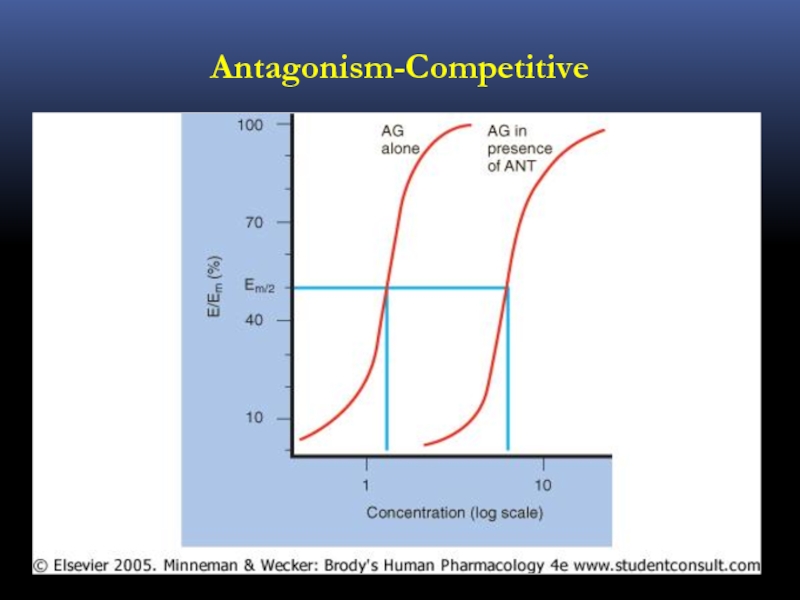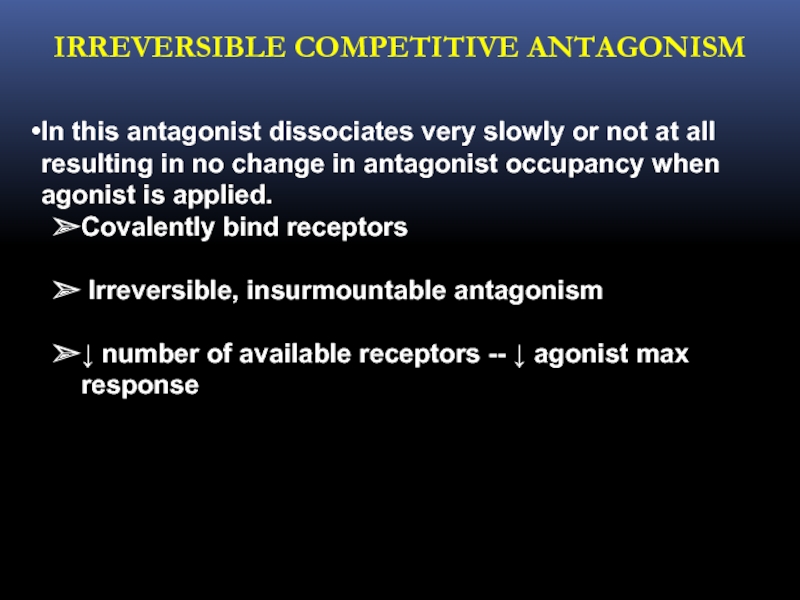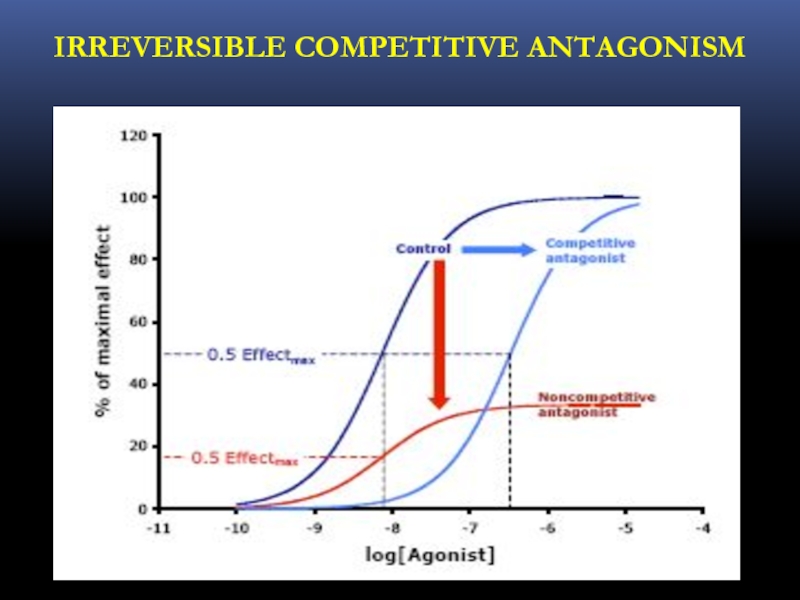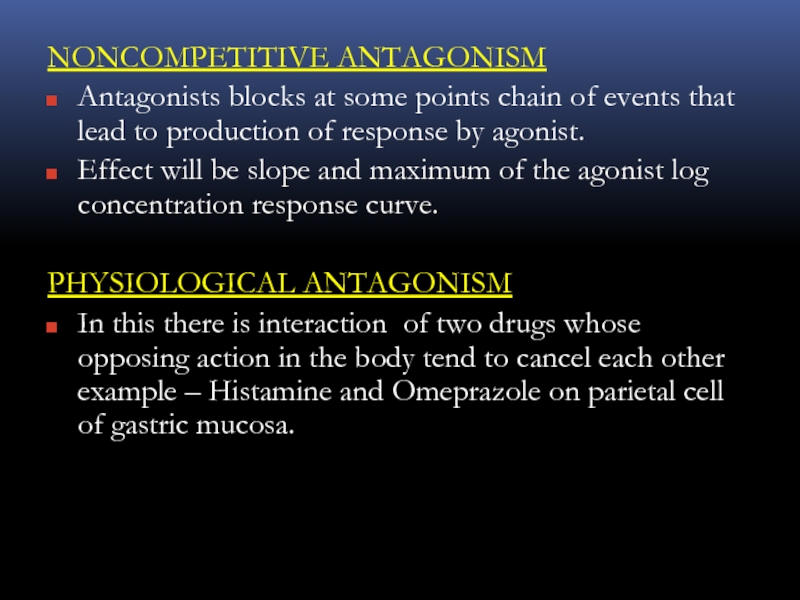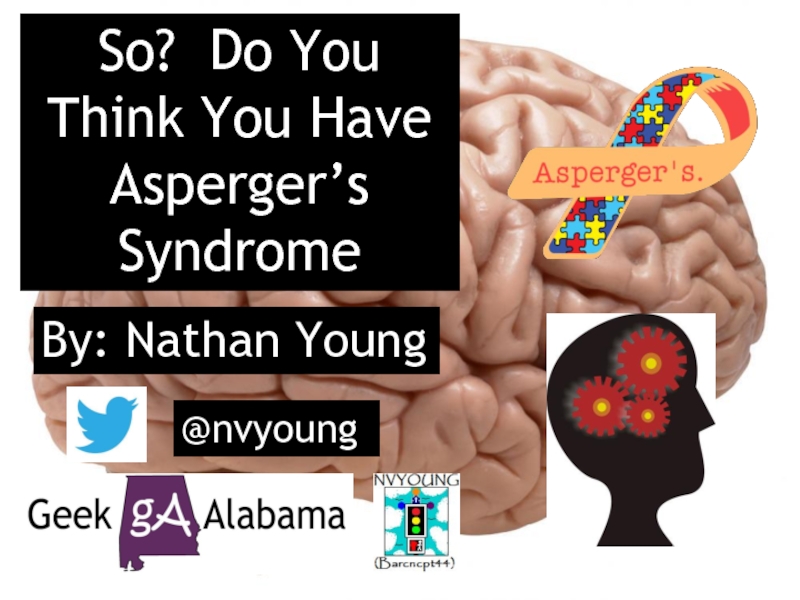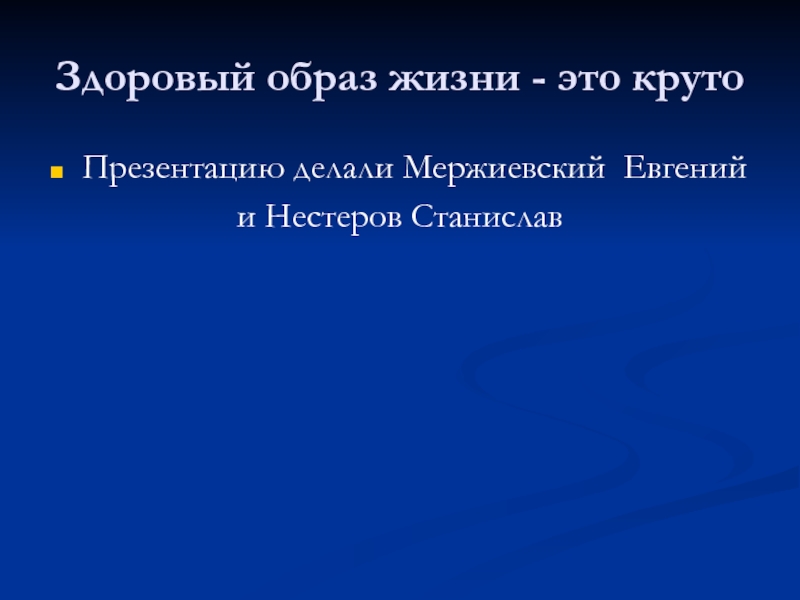- Главная
- Разное
- Дизайн
- Бизнес и предпринимательство
- Аналитика
- Образование
- Развлечения
- Красота и здоровье
- Финансы
- Государство
- Путешествия
- Спорт
- Недвижимость
- Армия
- Графика
- Культурология
- Еда и кулинария
- Лингвистика
- Английский язык
- Астрономия
- Алгебра
- Биология
- География
- Детские презентации
- Информатика
- История
- Литература
- Маркетинг
- Математика
- Медицина
- Менеджмент
- Музыка
- МХК
- Немецкий язык
- ОБЖ
- Обществознание
- Окружающий мир
- Педагогика
- Русский язык
- Технология
- Физика
- Философия
- Химия
- Шаблоны, картинки для презентаций
- Экология
- Экономика
- Юриспруденция
RECEPTORS AND RECEPTORSUPERFAMILIES Dr.Rahul Kunkulol Asso. Professor dept. of PharmacologyRMC,LONI презентация
Содержание
- 1. RECEPTORS AND RECEPTORSUPERFAMILIES Dr.Rahul Kunkulol Asso. Professor dept. of PharmacologyRMC,LONI
- 2. INTRODUCTION “Corpora non agunt nisi fixate”. P.
- 3. Drugs
- 5. Drugs
- 6. DRUG SPECIFICITY
- 7. Targets for drug action
- 8. Targets for drug action
- 9. ION CHANNELS
- 10. ENZYMES
- 11. CARRIER MOLECULE The transport across cell membranes
- 12. RECEPTOR Receptor are the sensing elements in
- 13. Drug and receptor
- 14. DRUG RECEPTOR INTERACTION Receptor mediated response
- 15. CONCEPT OF RECEPTOR Some authors used
- 16. Drug-Receptor Interactions Drug-receptor interactions serve as
- 17. Classification of Receptors IUPHAR (International Union of
- 18. RECEPTOR SUPERFAMILIES
- 19. Type- Ionotropic receptors
- 20. LIGAND GATED ION CHANNELS
- 21. GATING MECHANISM Neurotransmitter Post synaptic membrane
- 22. STRUCTURE OF ACH NICOTINIC RECEPTOR
- 23. GABAA RECEPTOR
- 24. GABAA RECEPTOR
- 26. G – PROTEIN COUPLED RECEPTORS Type:
- 28. SIGNAL TRANSDUCTION
- 29. CLASSES OF G-PROTEINS Gs Gi Gq Go Amplification………..?
- 31. BIDIRECTIONAL CONTROL OF A TARGET ENZYME BY G PROTEIN ISOMERS
- 33. Receptor Signaling Pathways Adenylate Cyclase (AC) Guadenylyl
- 34. Adenylate Cyclase ATP
- 35. REGULATION OF ENERGY BY CAMP
- 36. PHOSPHOLIPASE C
- 37. ION CHANNELLS AS TARGET FOR G- PROTEINS
- 39. KINASE LINKED RECEPTORS Mediate the actions of
- 40. SIGNAL TRANSDUCTION Receptor Ligand binding
- 43. NUCLEAR RECEPTORS Nuclear receptors regulate gene transcription.
- 44. Steroid Receptor Confomational change Dimer
- 45. NUCLEAR RECEPTORS
- 46. RECEPTOR SUPERFAMILIES
- 47. RECEPTOR SUPERFAMILIES
- 48. LIGAND GATED ION CHANNELS
- 49. G – PROTEIN – COUPLED RECEPTORS
- 51. KINASE LINKED RECEPTORS
- 52. NUCLEAR RECEPTORS
- 53. DESENSITISATION & TACHYPHYLAXIS Definition: TACHYPHYLAXIS
- 54. MECHANISMS Loss or change in receptors Exhaustion
- 55. Drug-Receptor Interactions Theory and assumptions of drug-receptor
- 57. Agonism and Antagonism
- 58. Cont.. AGONIST: Binding + Activation Agonists facilitate
- 59. PARTIAL & FULL AGONIST
- 60. Partial Agonists Full agonists → max response
- 61. Comparison of Affinity & Efficacy of Ligands
- 62. TWO STATE MODEL The receptor shows the
- 63. In the presence of ligand (A) equilibrium
- 64. R+D=
- 65. DRUG ANTAGONISM The effect of one drug
- 66. Cont… CHEMICAL ANTAGONISM Two substances combine
- 67. REVERSIBLE COMPETITIVE ANTAGONISM Antagonist binds
- 68. Antagonism-Competitive
- 69. IRREVERSIBLE COMPETITIVE ANTAGONISM In this antagonist
- 70. IRREVERSIBLE COMPETITIVE ANTAGONISM
- 71. NONCOMPETITIVE ANTAGONISM Antagonists blocks at some
- 72. Thank You
Слайд 1 RECEPTORS AND RECEPTOR SUPERFAMILIES Dr.Rahul Kunkulol Asso. Professor dept.
Слайд 2INTRODUCTION
“Corpora non agunt nisi fixate”.
P. Ehrlich (1908)
Paul Ehrlich described drug-receptor binding:
(“Agents
Слайд 11CARRIER MOLECULE
The transport across cell membranes of ions and organic molecules
Слайд 12RECEPTOR
Receptor are the sensing elements in the system of chemical communications
Chemical messengers :
Hormones Drugs Transmitters Other mediators
Слайд 14DRUG RECEPTOR INTERACTION
Receptor mediated response
Binding
Activation
Occupation of receptor by a
result in activation of the receptor.
Слайд 15CONCEPT OF RECEPTOR
Some authors used it to mean any target
In Pharmacology it is best to reserve the term receptor for interaction of regulatory type where a small molecule (Ligand) may function as agonist or as an antagonist.
In practice this limits use of term receptors that have physiological regulatory function
Слайд 16
Drug-Receptor Interactions
Drug-receptor interactions serve as signals to trigger a cascade of
Effectors are thus the molecules that translate the drug-receptor interaction into changes in cellular activity.
∙ ➔ ∙ + • ➔ • ➔ • ➔ • ❍•◎ ↘ EFFECT
DRUG DRUG + RECEPTOR DRUG + RECEPTOR EFFECTOR EFFECTOR
INTERACTION COMPLEX SYSTEM
STIMULUS BINDING ACTIVATION TRANSDUCTION AMPLIFICATION RESPONSE
SIGNALLING PATHWAY
Слайд 17Classification of Receptors
IUPHAR (International Union of Pharmacological Science)
Pharmacological
Mediator (i.e. Insulin, Norepinephrine,
Biochemical and Biophysical
Second messenger system (i,.e. cAMP, PLC, PLA)
Molecular or Structural
Subunit composition (i.e. 5HT1A )
Anatomical
Tissue (i.e muscle vs ganglionic nAChRs)
Cellular (i.e. Membrane bound vs Intracellular)
Слайд 18 RECEPTOR SUPERFAMILIES
LIGAND- GATED ION CHANNELS
G-PROTEIN COUPLED RECEPTORS
KINASE LINKED RECEPTORS
NUCLEAR RECEPTORS
Слайд 19Type- Ionotropic receptors
Location-cell membrane
Effector-ion channel
Coupling-direct
Examples-Fast neurotransmitters :
Nicotinic Ach
Glutamate
GABAA,
LIGAND GATED ION CHANNELS
Слайд 21GATING MECHANISM
Neurotransmitter
Post synaptic membrane inotropic receptor (LGIC)
Increased permeability of ions
Depolarization
Action potential
Слайд 25
GABA
metabolites
Succinic
Semialdehyde
GT: GABA transaminase
SSD: Succinic semialdehyde dehydrogenase
GT
SSD
Cl-
Слайд 26G – PROTEIN COUPLED RECEPTORS
Type: Metabotropic
Location: Cell membrane
Coupling: G-protein
Exampels-
Muscarinic, Adrenergic,
Opioid,
5HT,Peptides,Purines
Слайд 33Receptor Signaling Pathways
Adenylate Cyclase (AC)
Guadenylyl Cyclase (GC)
Phospholipase C (PLC)
Phospholipase A (PLA2)
Nitric
Ions
cAMP
cGMP
DAG and IP3
Arachidonic acid
NO and CO
Na+, Ca2+, K+, Cl-
SECOND MESSENGER
EFFECTOR
Слайд 34 Adenylate Cyclase
ATP cAMP
Phosphorylation of
cell proteins
5AMP
Enzymes involved in energy metabolism, cell division, cell differentiation,
ion channels, and contractile proteins in smooth muscles
Слайд 37ION CHANNELLS AS TARGET FOR G- PROTEINS
GPCR controls ion channels directly
Either alpha or beta and gamma subunits of G protein acts as second messenger
Ex-m ACH receptor enhances K+ permeability
Слайд 39KINASE LINKED RECEPTORS
Mediate the actions of wide variety of proteins mediators
Receptor for various hormones (insulin) & growth factor incorporate tyrosine kinase activity in their intracellular domain.
Cytokine receptors have intracellular domain that activates cytosolic kinases when the receptor is occupied.
Слайд 40SIGNAL TRANSDUCTION
Receptor
Ligand binding
Dimerisation of receptor
Autophosporylation of tyrosine residue
Binding of intracellular
Gene transcription
Слайд 43NUCLEAR RECEPTORS
Nuclear receptors regulate gene transcription.
Nuclear receptor-a misnomer as they
Examples: Steroid hormones, thyroid hormones retinoic acid and vit. D.
Слайд 44Steroid
Receptor
Confomational change
Dimer
Move to nucleus and bind to hormone –
Increase RNA Polymerase activity
Production of specific m RNA
Слайд 53DESENSITISATION & TACHYPHYLAXIS
Definition:
TACHYPHYLAXIS
The effect of a drug gradually
Tolerance is conventionally used to describe a more gradual decrease in responsiveness to a drug, taking days or weeks to develop.
The distinction is not sharp.
Refractoriness is used to indicate loss of therapeutic efficacy.
Drug resistance is used to indicate loss of effectiveness of antimicrobial or anti tumor drugs.
Слайд 54MECHANISMS
Loss or change in receptors
Exhaustion of mediators
↑ metabolic degradation
Physiological adaptation
Active extrusion
Слайд 55Drug-Receptor Interactions
Theory and assumptions of drug-receptor interactions.
Drug Receptor interaction follows simple
The magnitude of the response is proportional to the fraction of total receptor sites occupied by drug molecules.
Combination or binding to receptor causes some event which leads to a response.
Response to a drug is graded or dose-dependent.
Слайд 58Cont..
AGONIST: Binding + Activation
Agonists facilitate receptor response
ANTAGONIST: If a drug binds
Tendency of a drug to bind the receptor is governed by its affinity, where as tendency of it, ones bound, to activate the receptor is denoted by its efficacy.
PARTIAL AGONISTS: Drugs with intermediate levels of efficacy, such that even if 100% of receptors are occupied the tissue response is sub maximal.
Слайд 60Partial Agonists
Full agonists → max response
Full response @ ~20% occupancy
Partial
100% occupancy → ~40% response
Слайд 61Comparison of Affinity & Efficacy of Ligands
Ligand Affinity Efficacy
Agonist ++++
Antagonist ++++ -
Partial agonist ++++ ++
Слайд 62TWO STATE MODEL
The receptor shows the two conformational stage resting (R)
R R*
Normally when no ligand is present, the equilibrium lies far to the left.
Слайд 63In the presence of ligand (A) equilibrium will depend on equilibrium
For pure antagonist it is zero.
For agonist it is a finite value.
For drug X β/α is small – partial agonist
For drug Y β/α is large – agonist
Therefore constant β/α is measure of efficacy
Слайд 65DRUG ANTAGONISM
The effect of one drug is diminished or completely abolished
CLASSIFICATION
Chemical antagonism
Pharmacokinetic antagonism
Antagonism by receptor block
Noncompetitive antagonism, i.e. block of receptor – effector linkage
Physiological antagonism
Слайд 66Cont…
CHEMICAL ANTAGONISM
Two substances combine in solution and effect of active drug
PHARMACOKINETIC ANTAGONISM
In this antagonist effectively reduces the concentration of the active drug at its site of action. This can happen various ways by increased metabolic degradation, decreased absorption or increased excretion.
Слайд 67REVERSIBLE COMPETITIVE ANTAGONISM
Antagonist binds receptor but does not activates it.
Incr’d
Antagonism “surmountable
In the presence of antagonist, the agonist log concentration effect curve is sifted to the right without change in slope or maximum.
Слайд 69IRREVERSIBLE COMPETITIVE ANTAGONISM
In this antagonist dissociates very slowly or not at
Covalently bind receptors
Irreversible, insurmountable antagonism
↓ number of available receptors -- ↓ agonist max response
Слайд 71NONCOMPETITIVE ANTAGONISM
Antagonists blocks at some points chain of events that
Effect will be slope and maximum of the agonist log concentration response curve.
PHYSIOLOGICAL ANTAGONISM
In this there is interaction of two drugs whose opposing action in the body tend to cancel each other example – Histamine and Omeprazole on parietal cell of gastric mucosa.
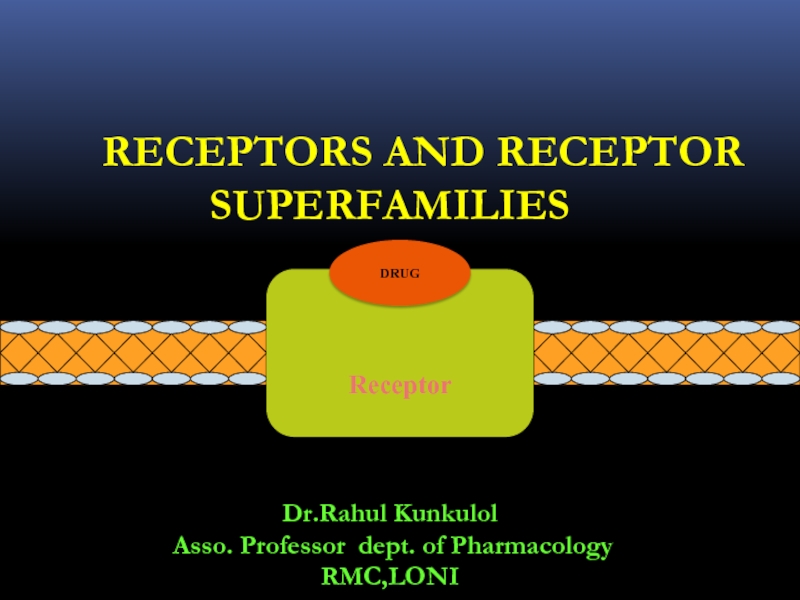
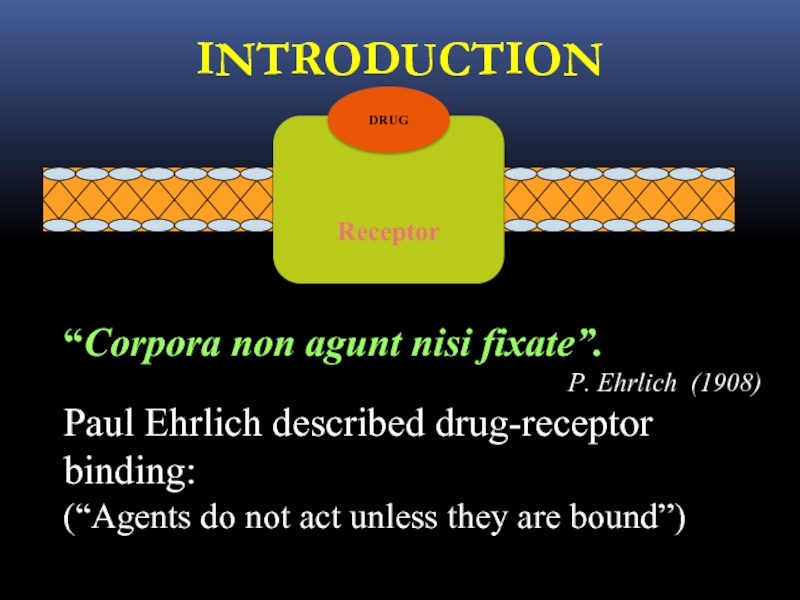
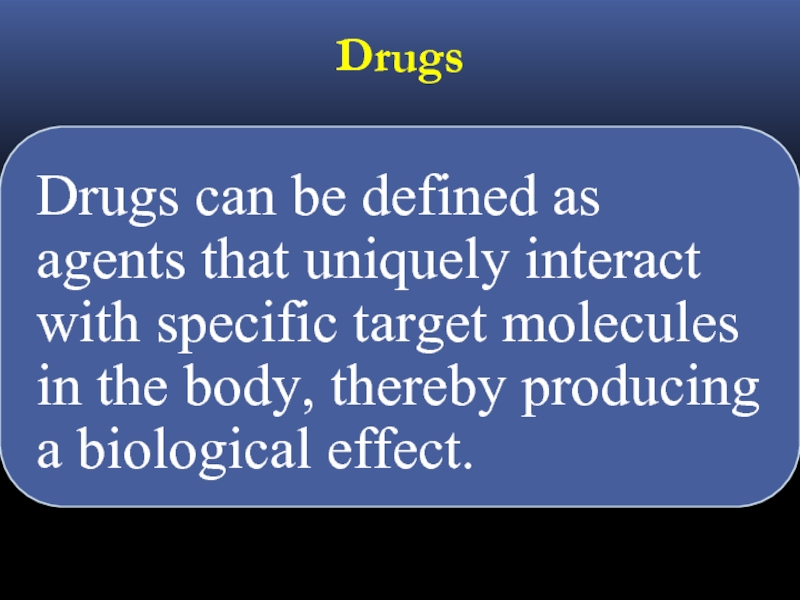

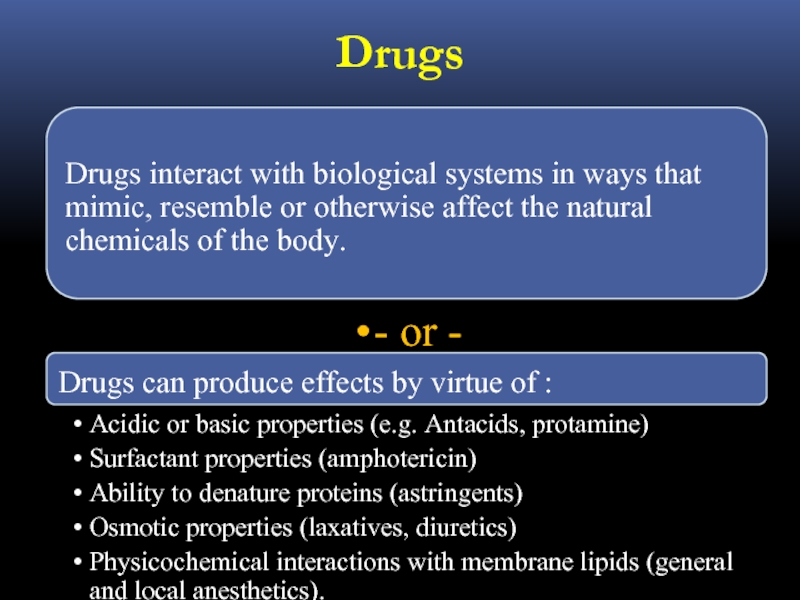
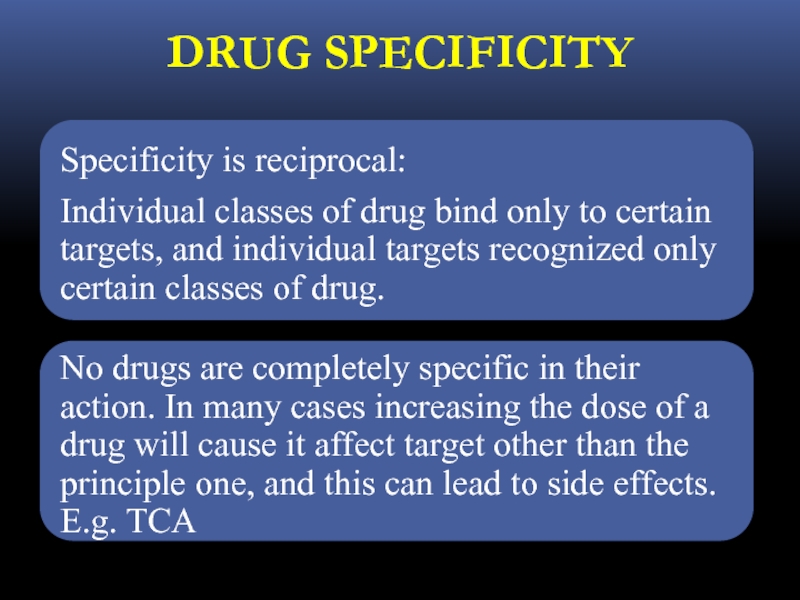
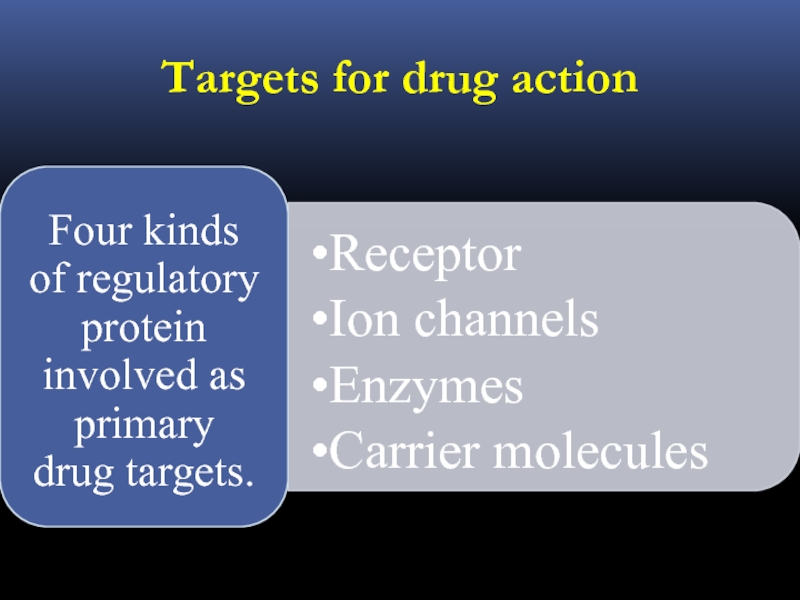
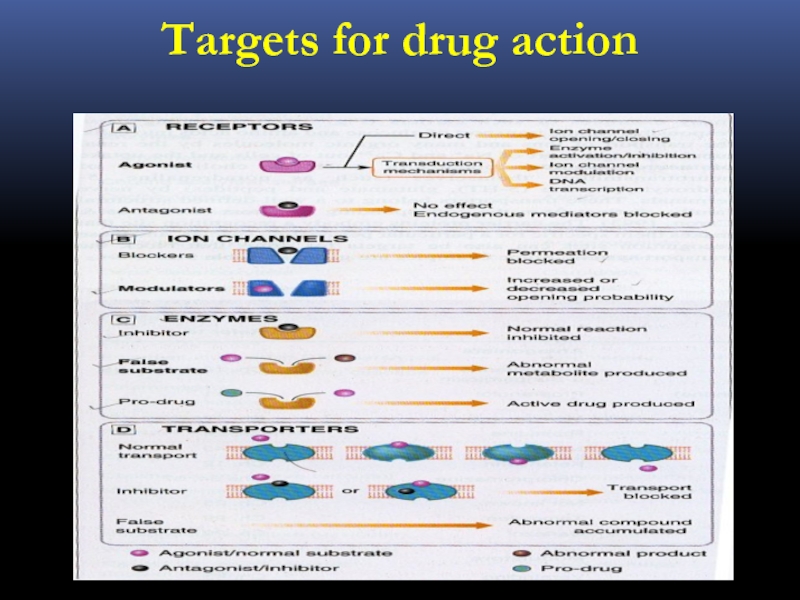

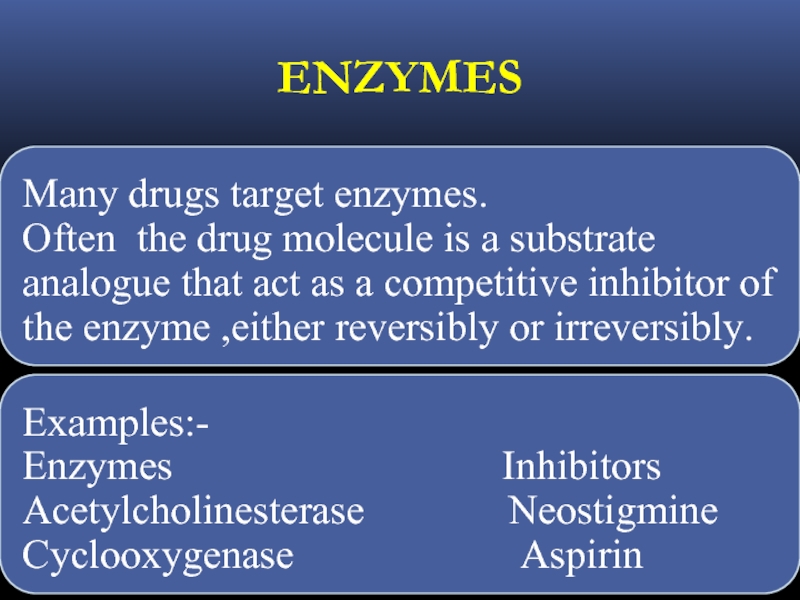
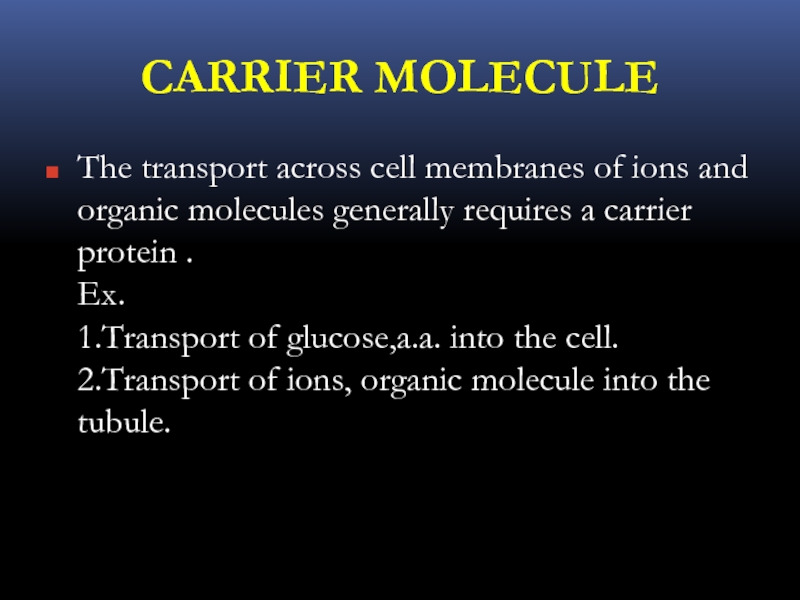
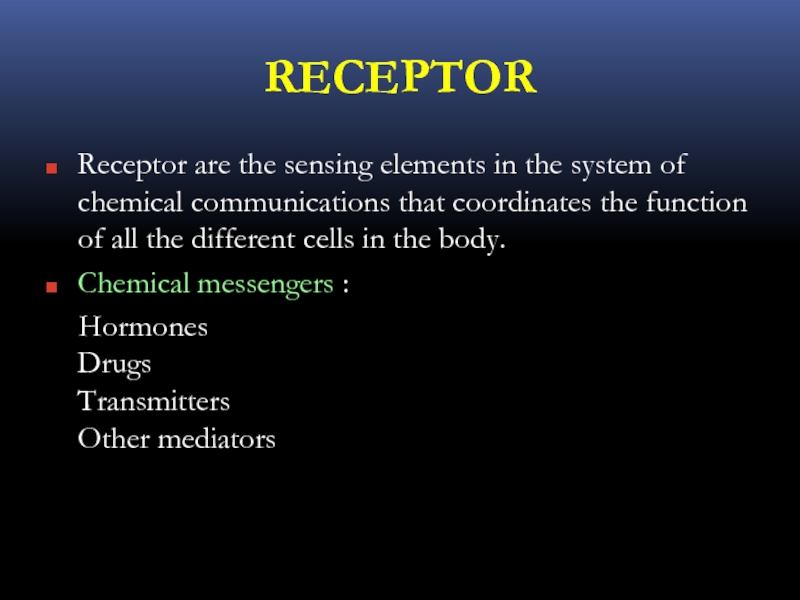
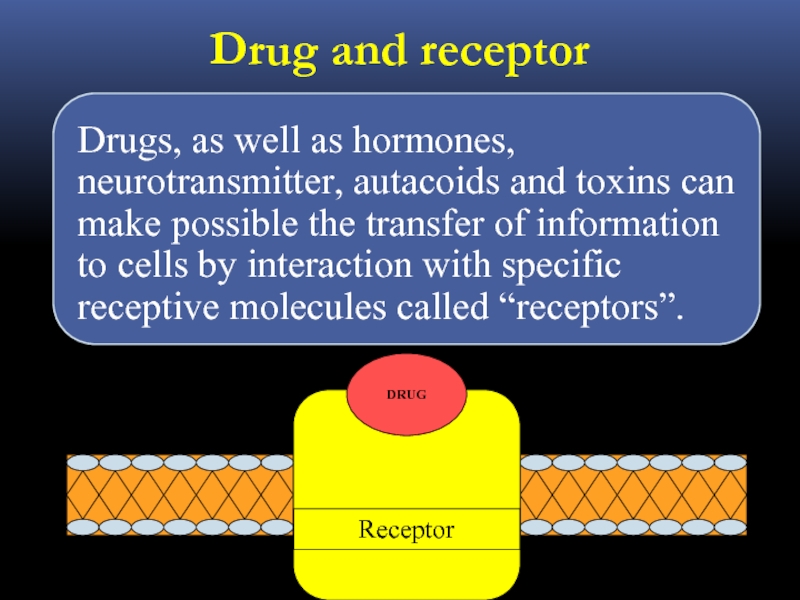
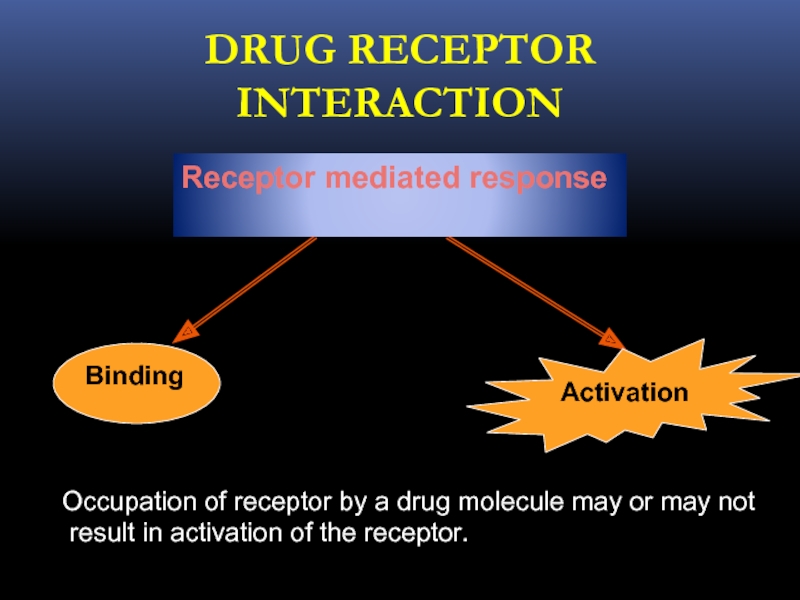
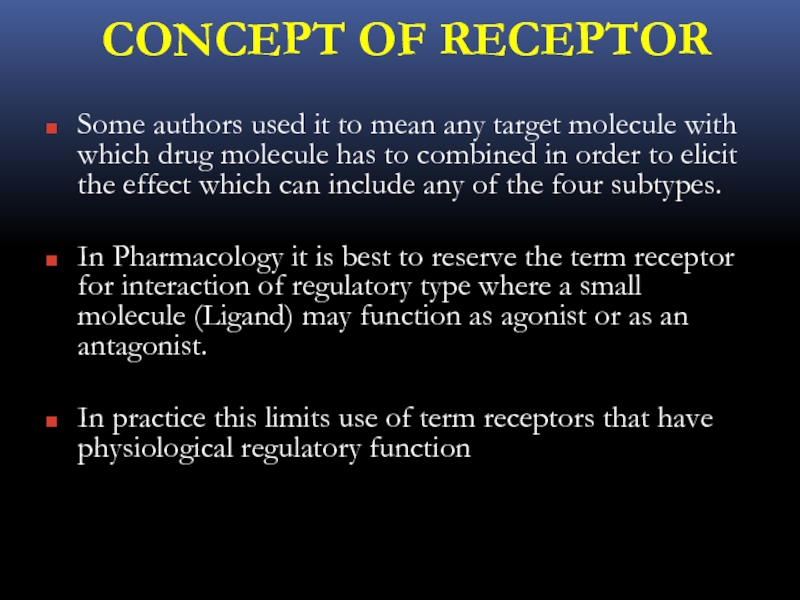
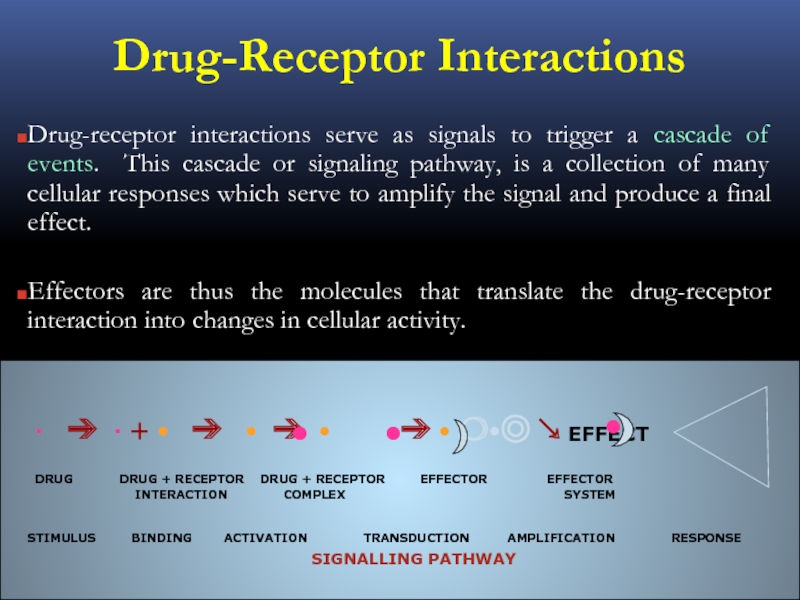
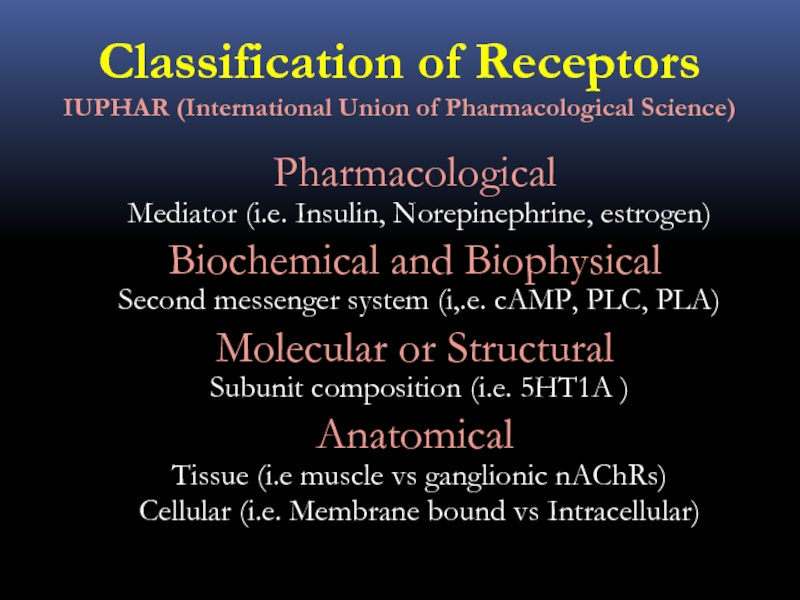
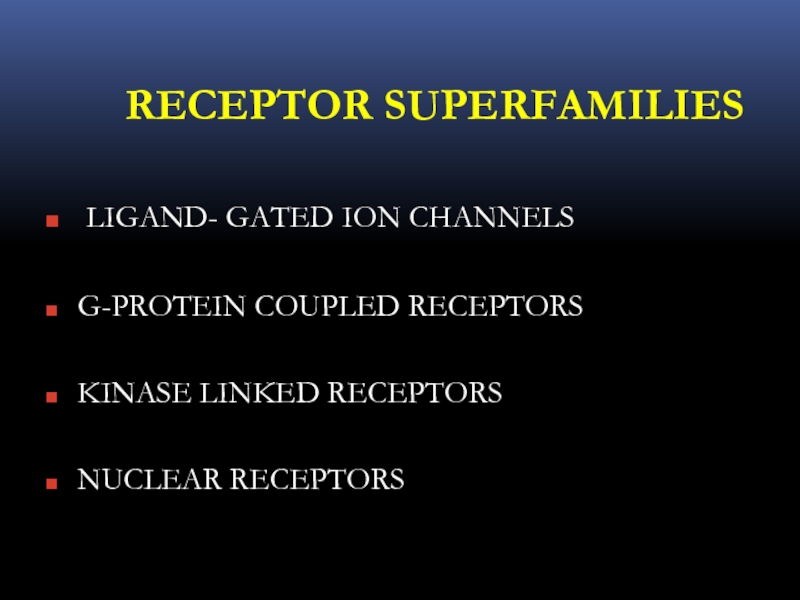
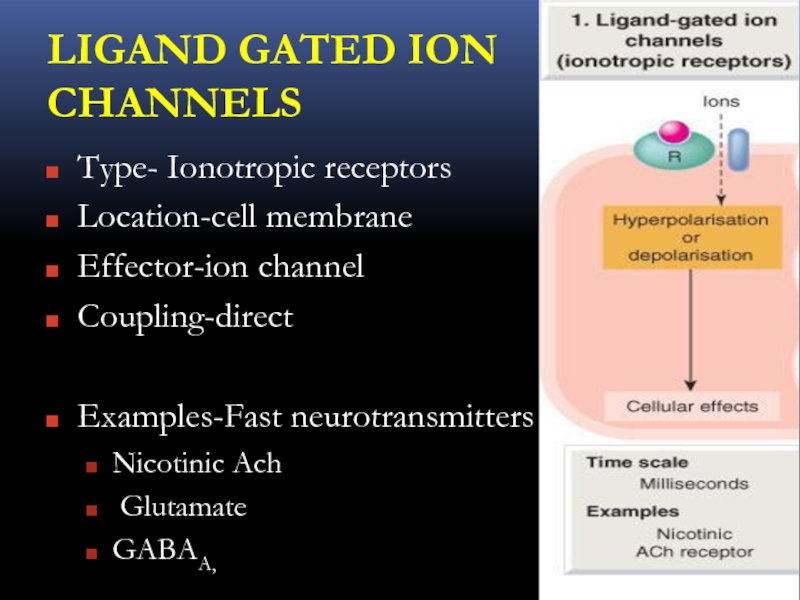
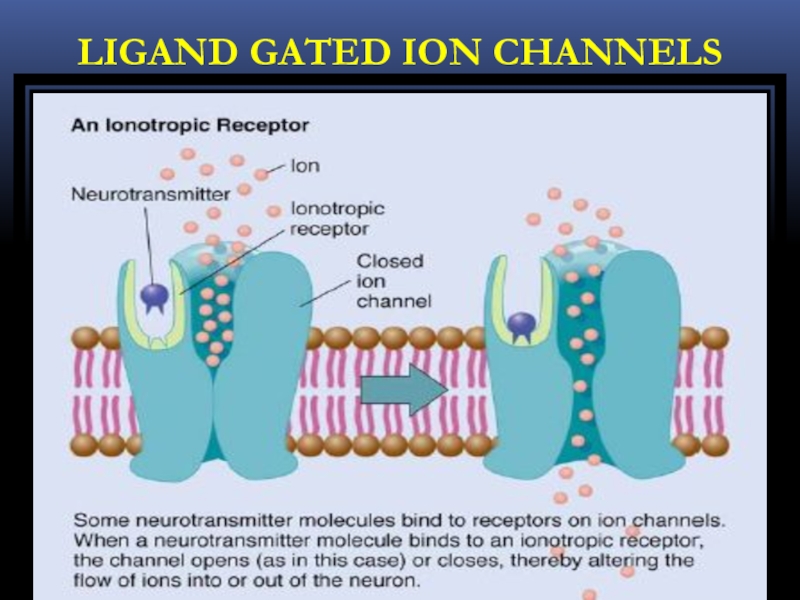
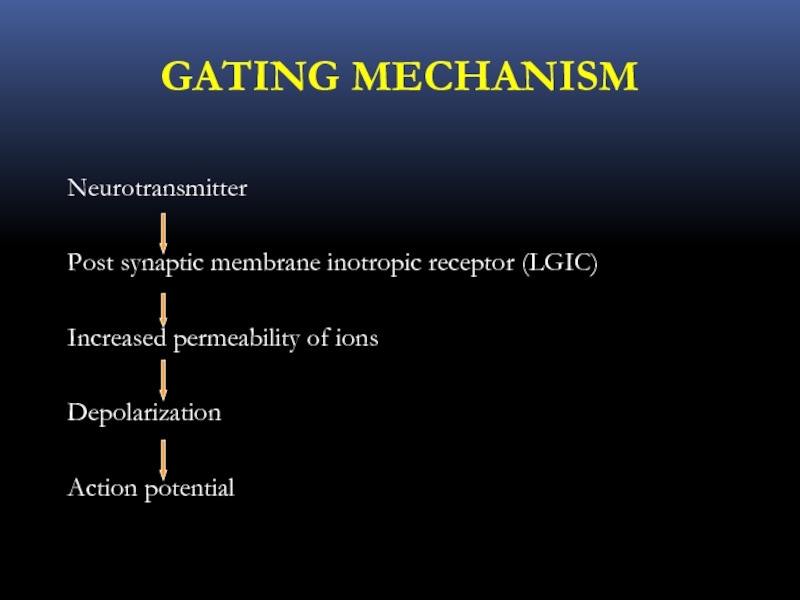
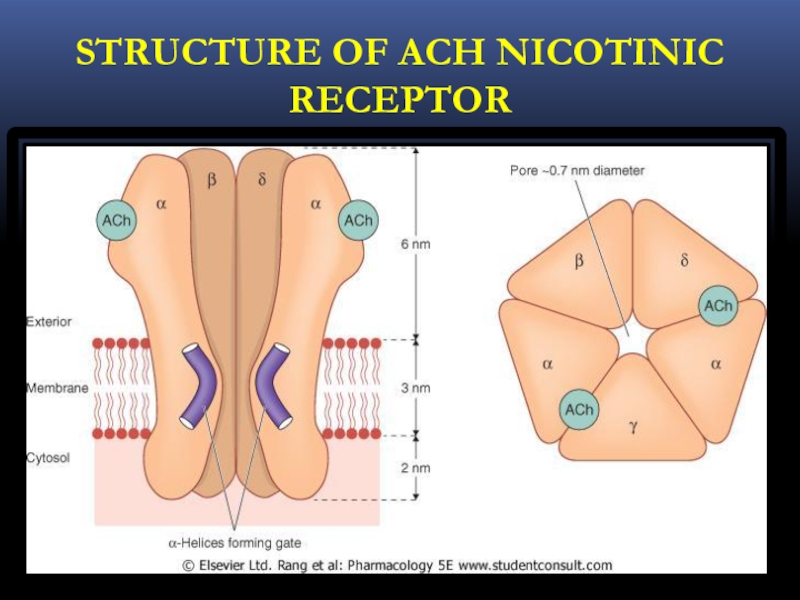

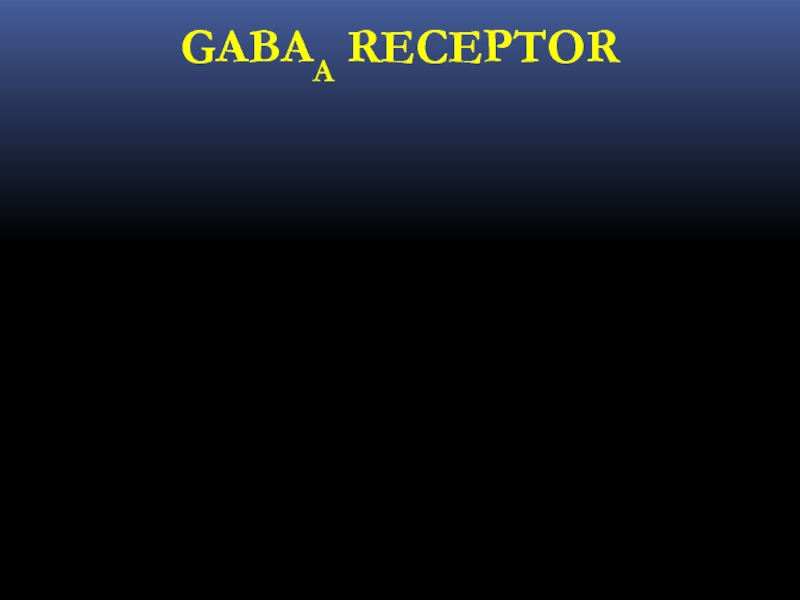
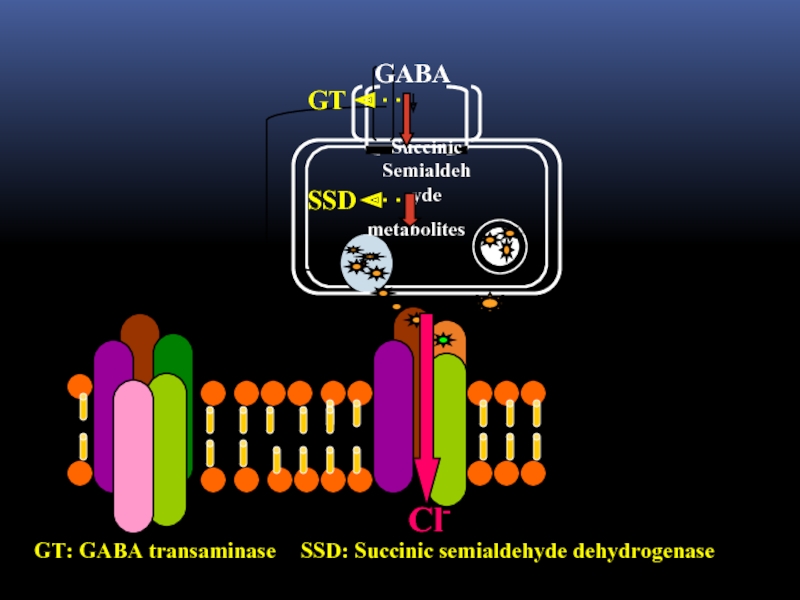
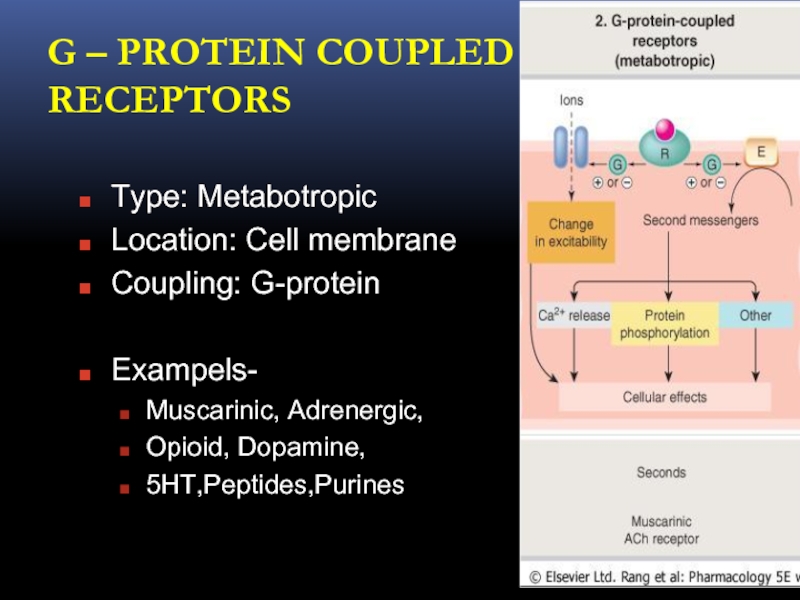
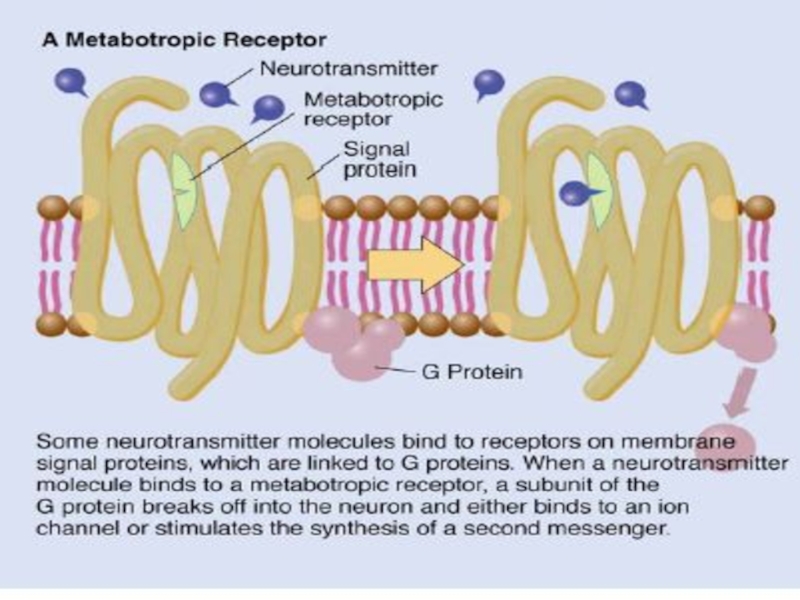
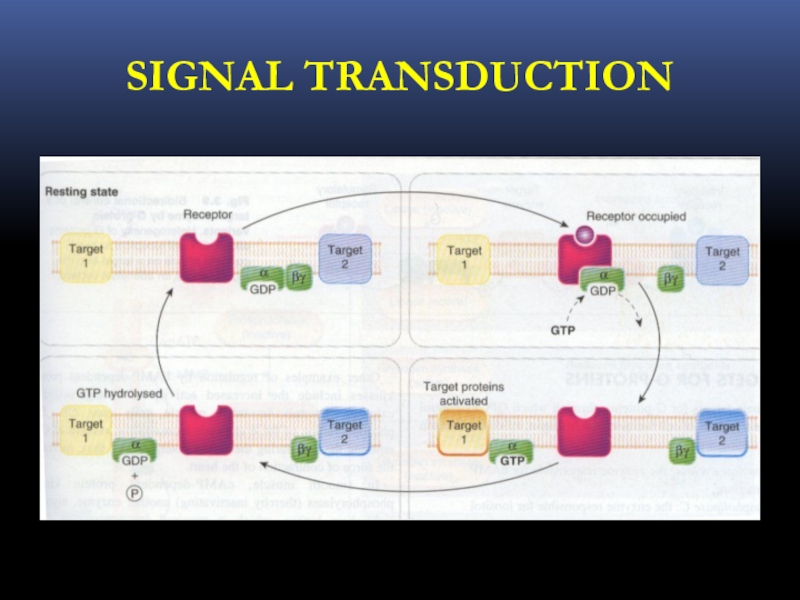
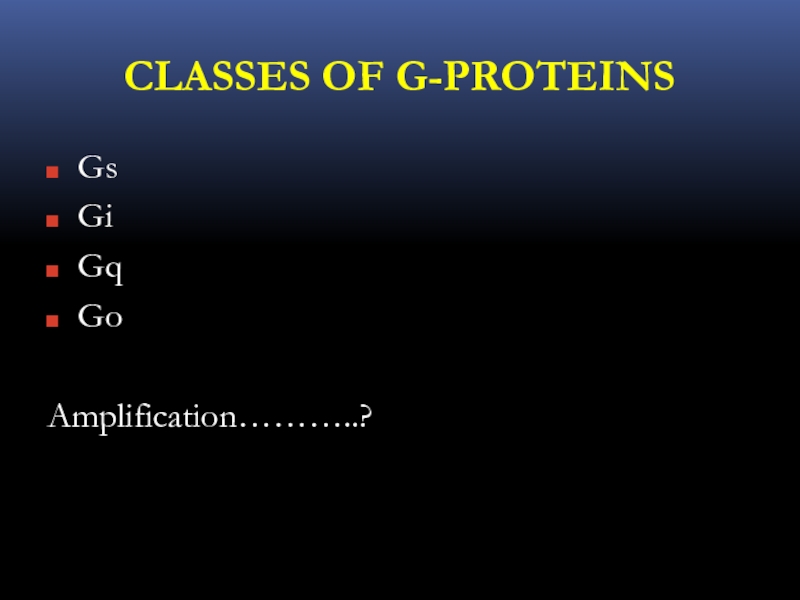
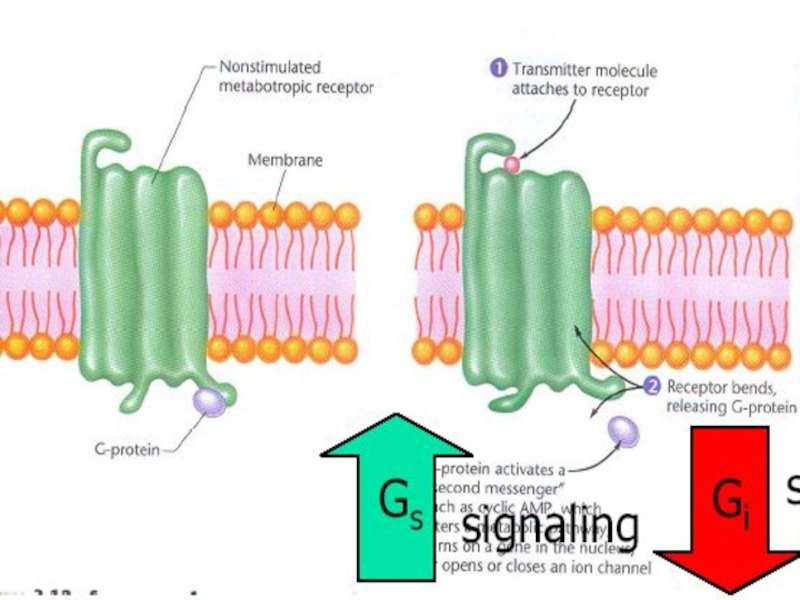
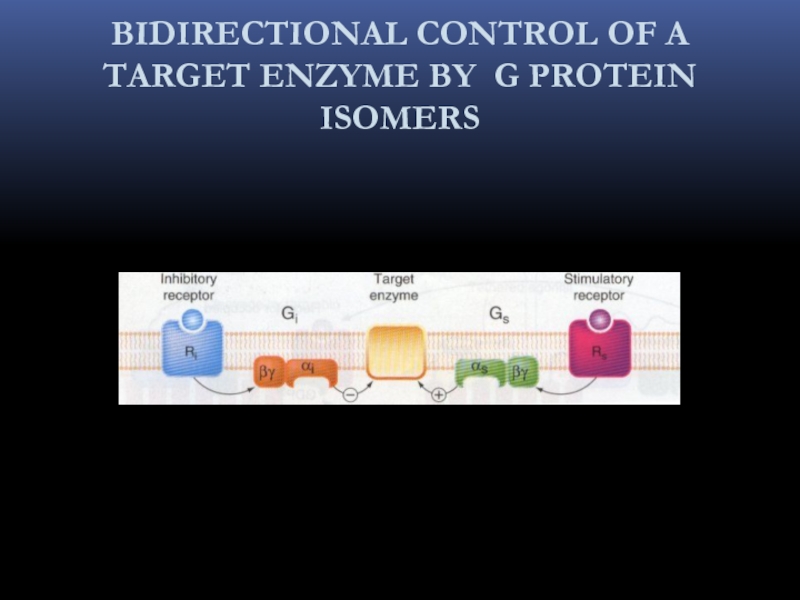
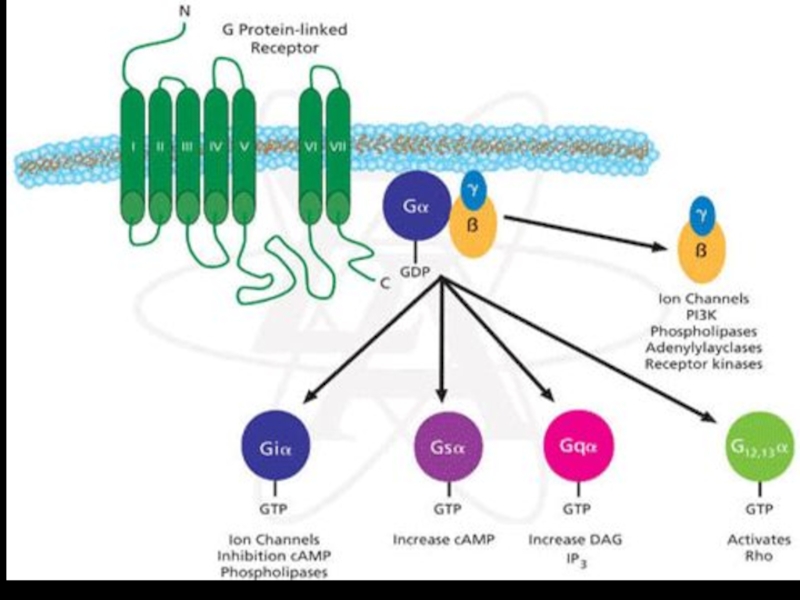
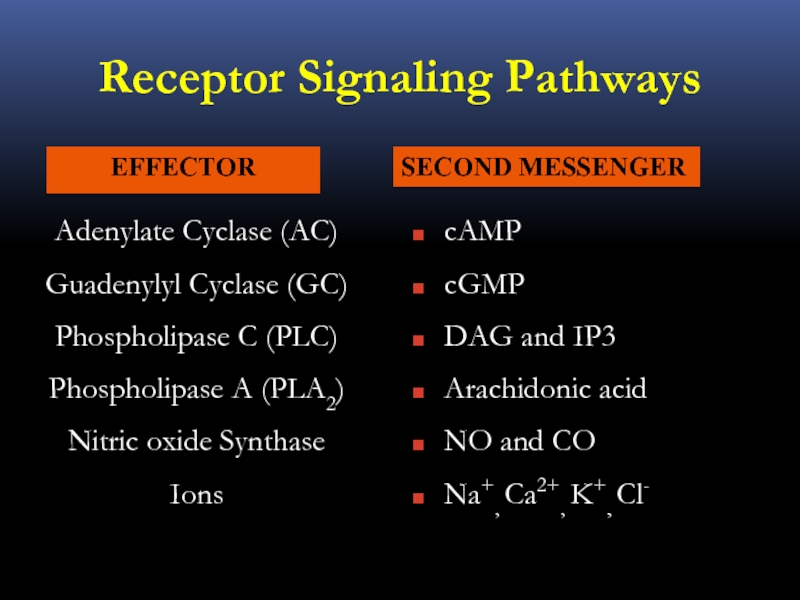
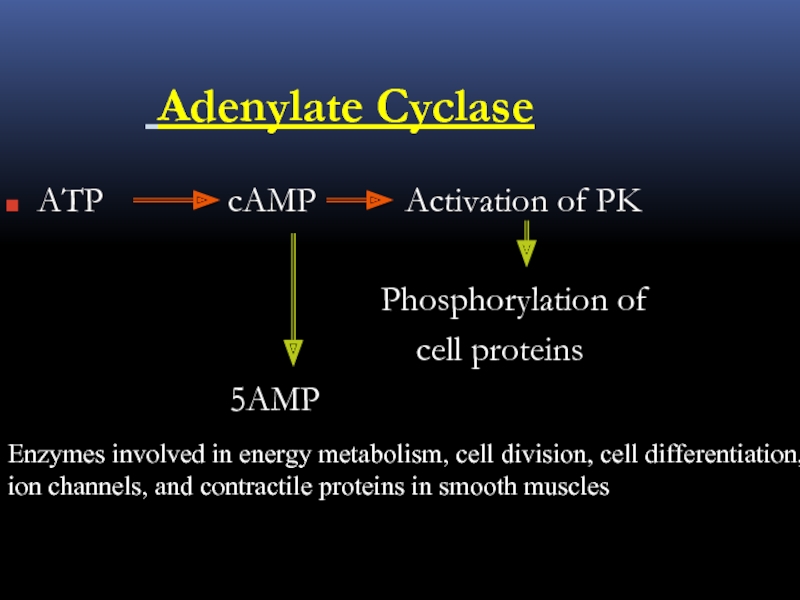

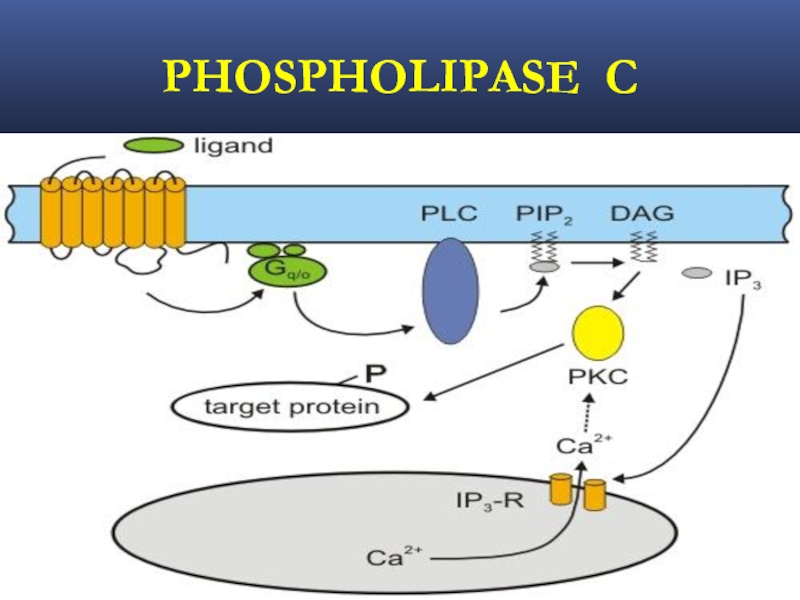
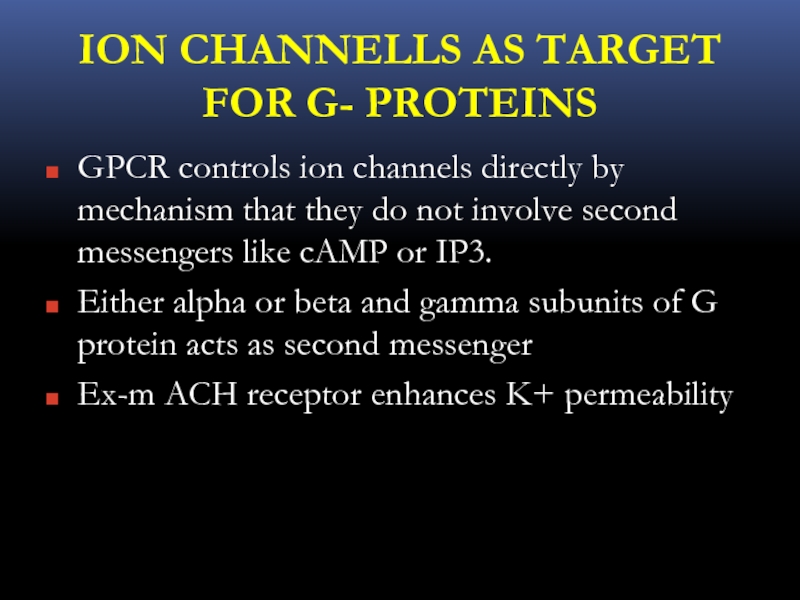
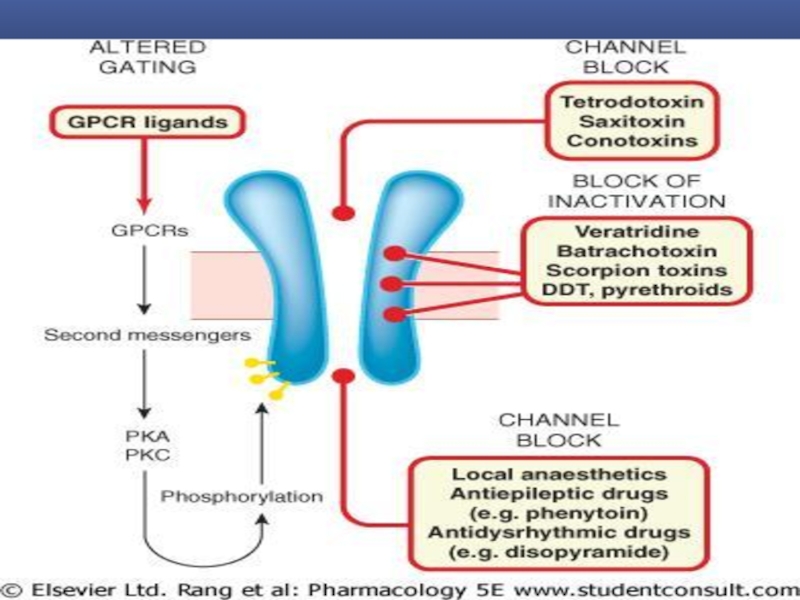
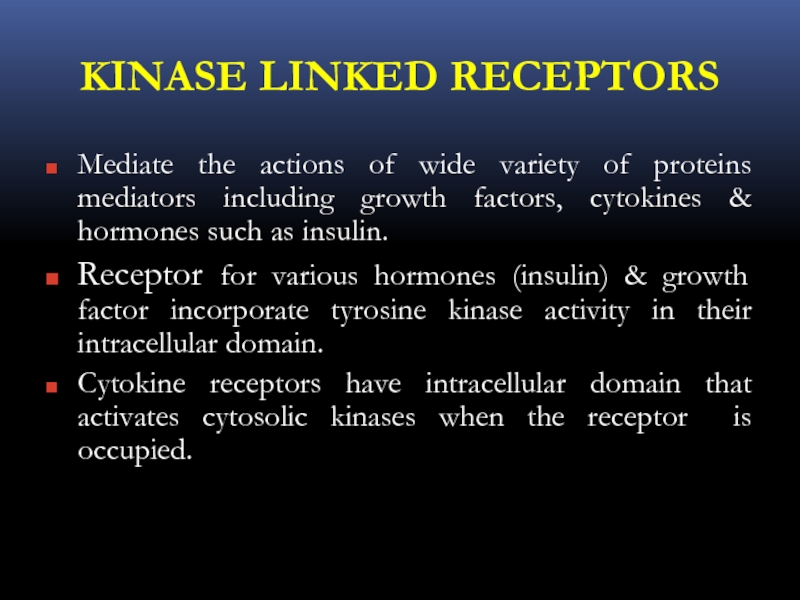
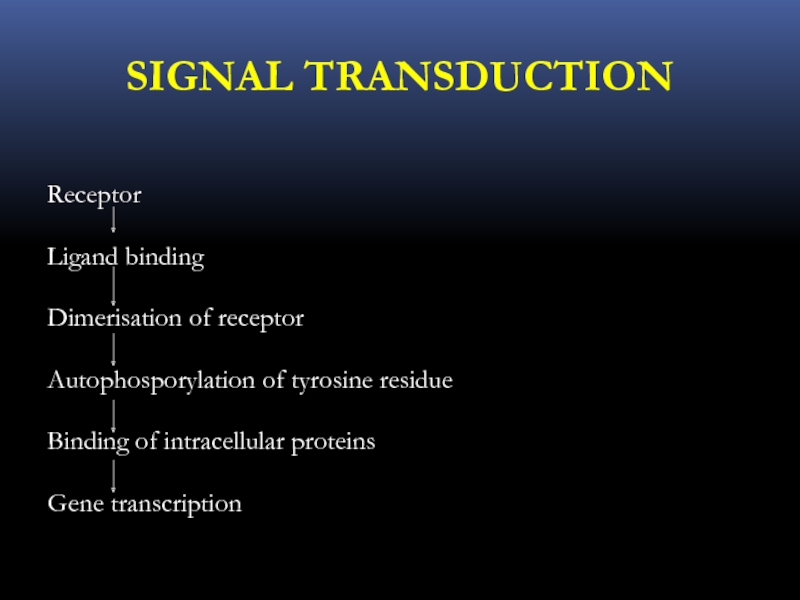

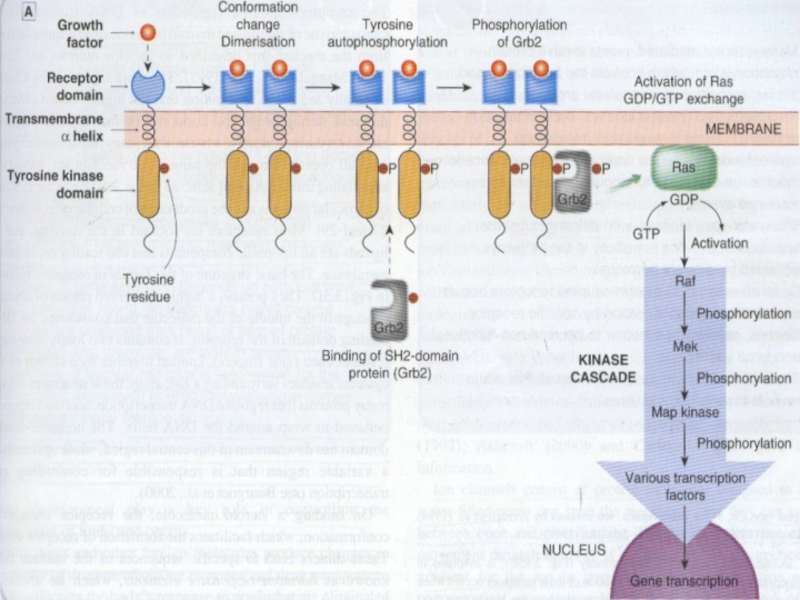
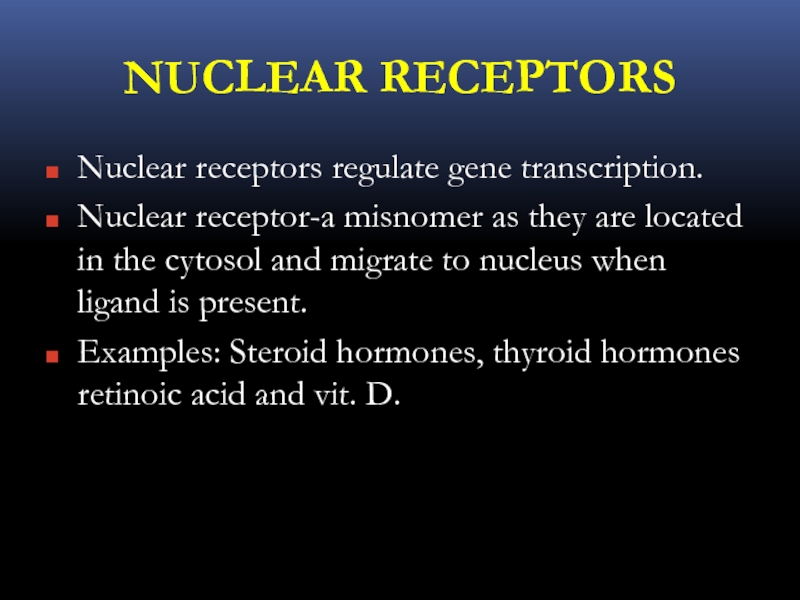
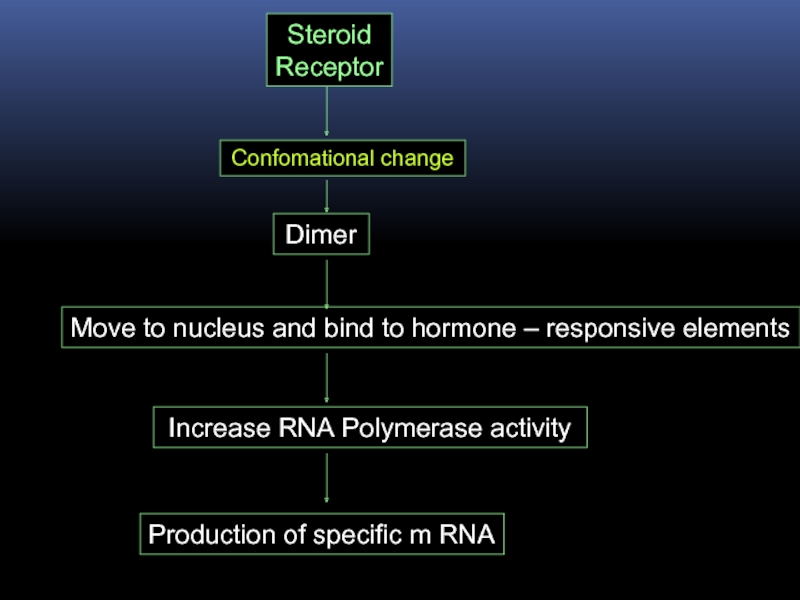
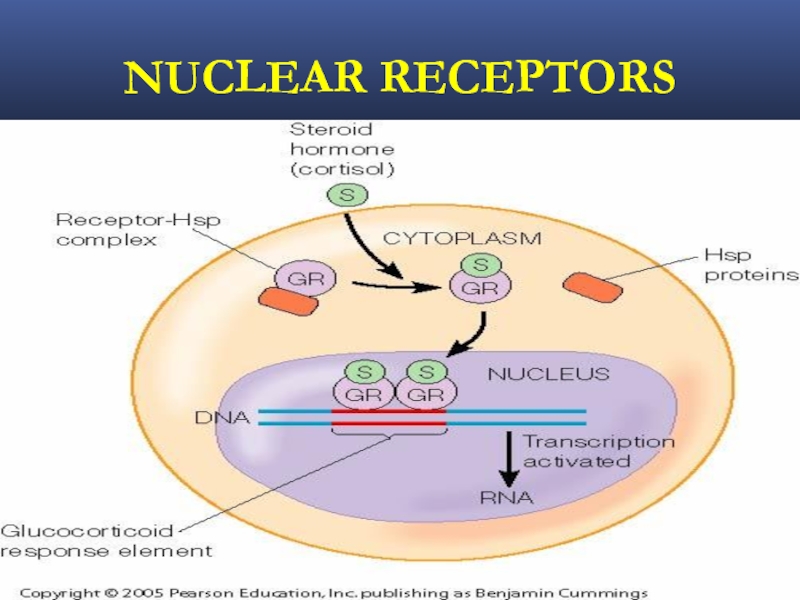
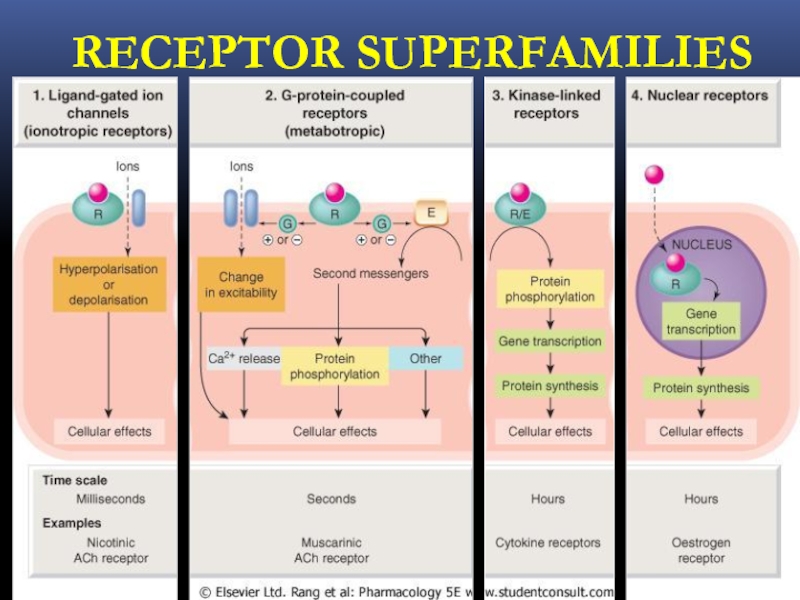
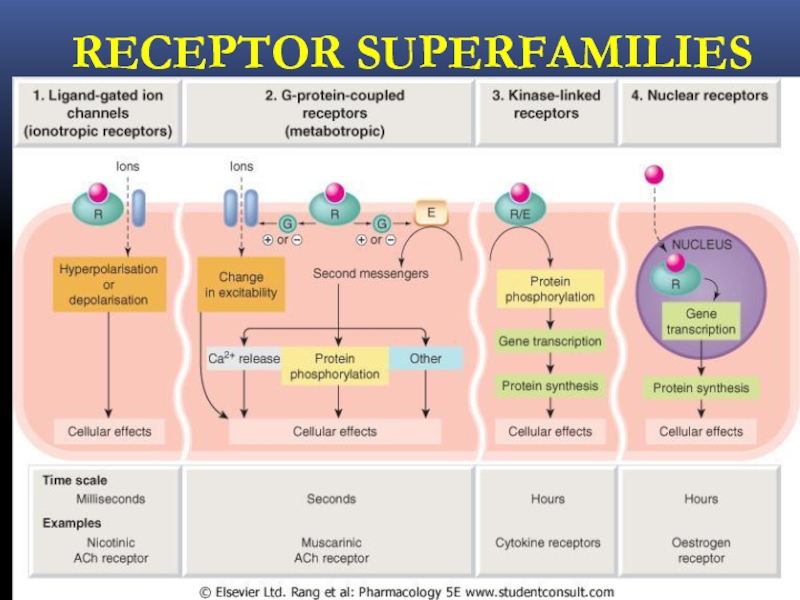
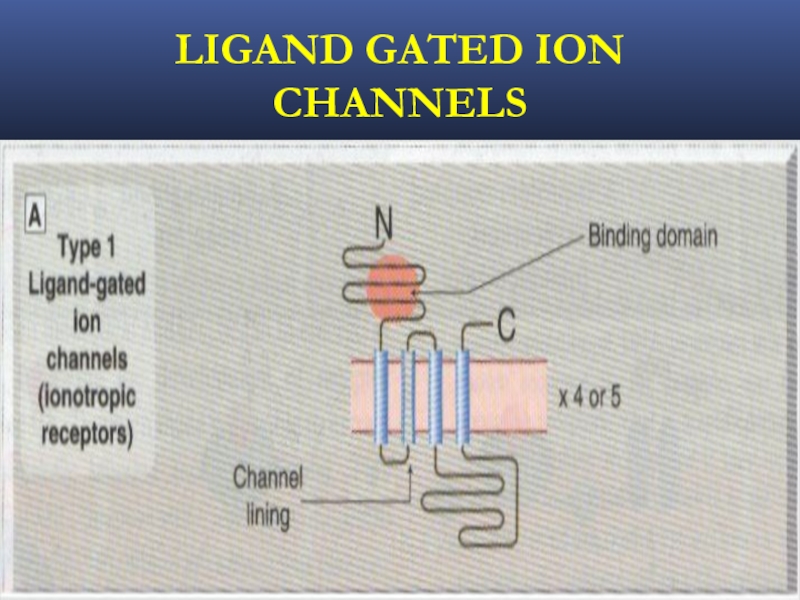
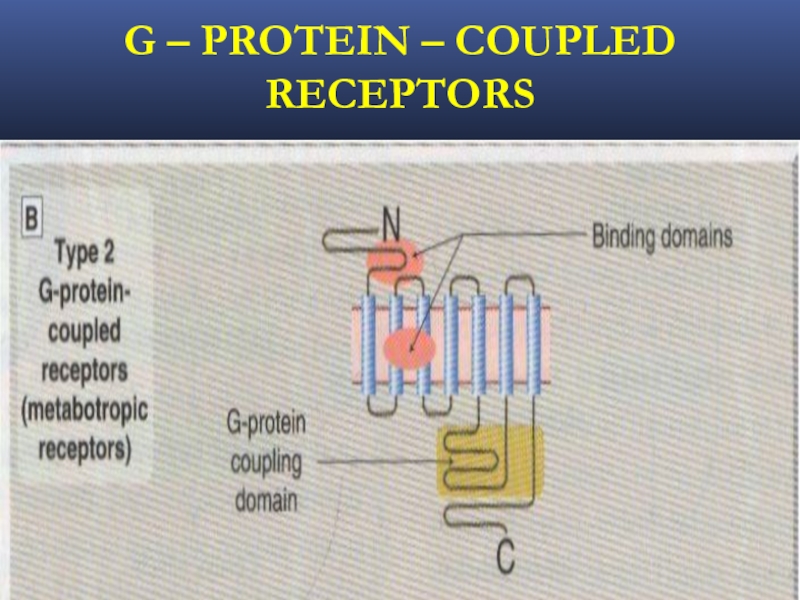

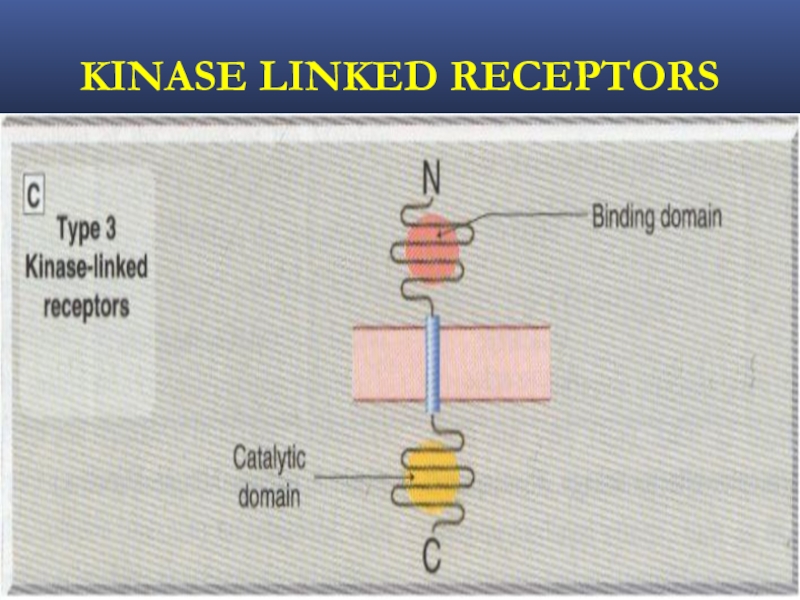
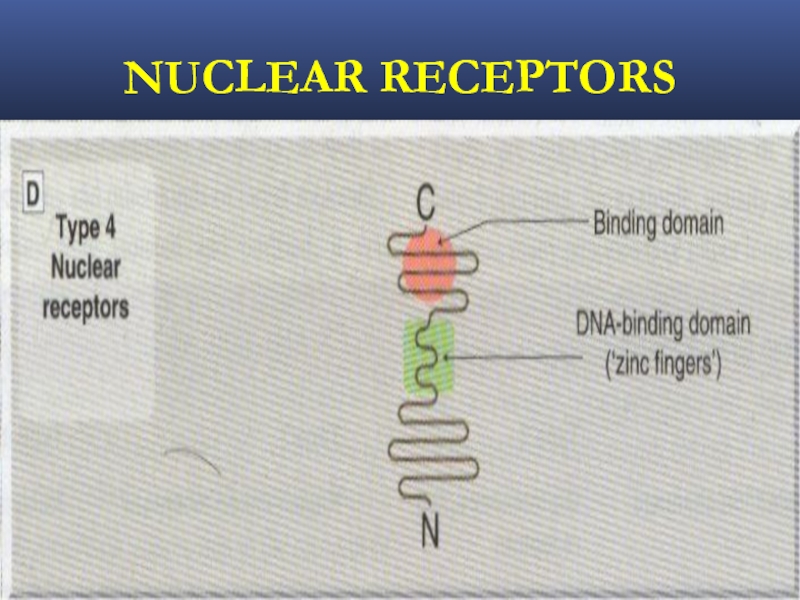
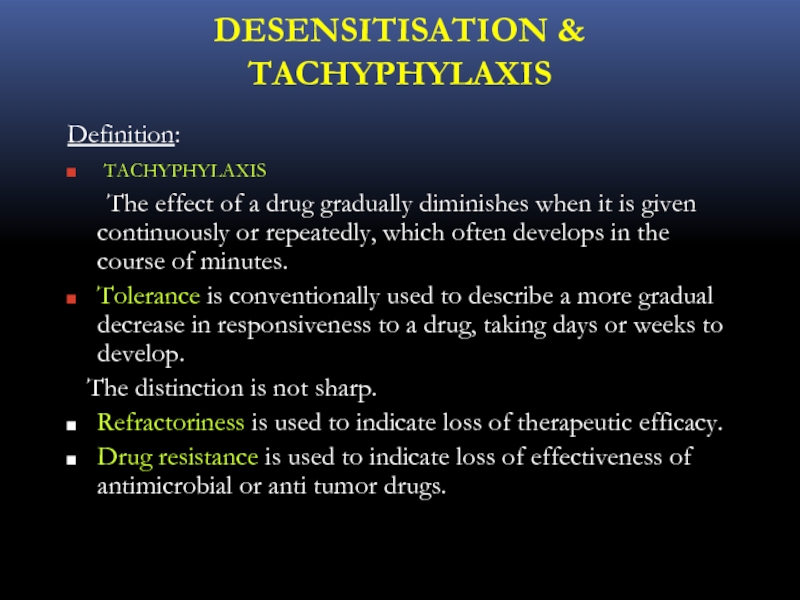
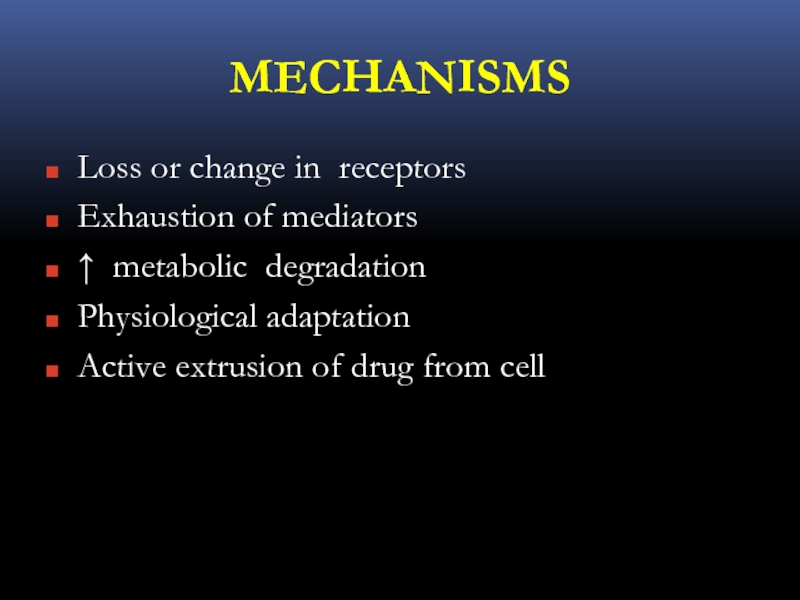
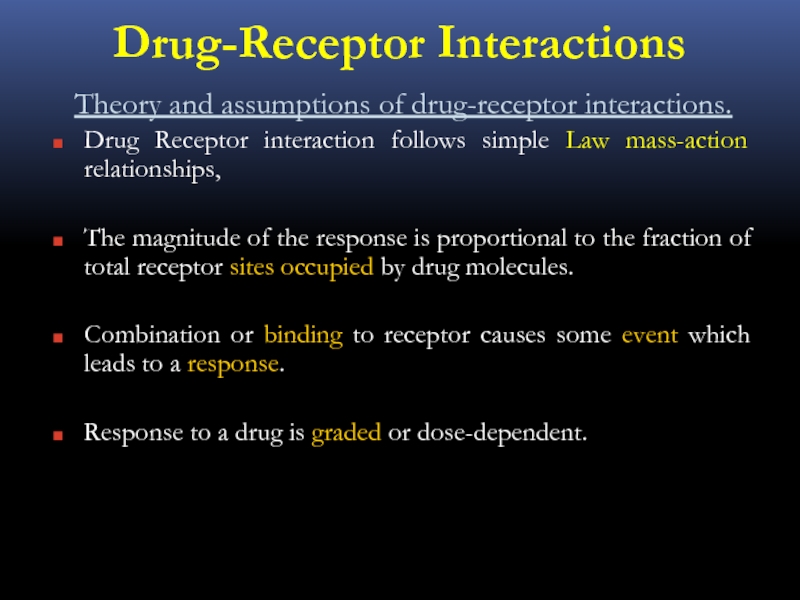
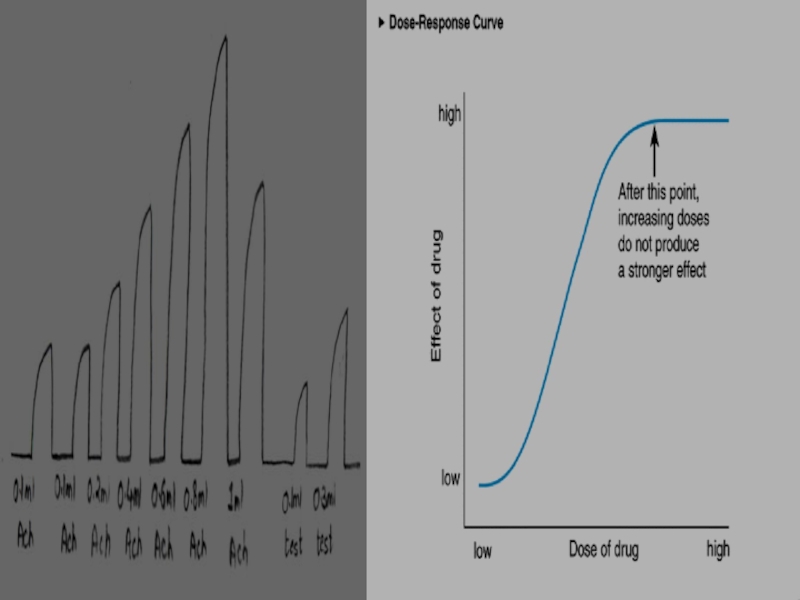
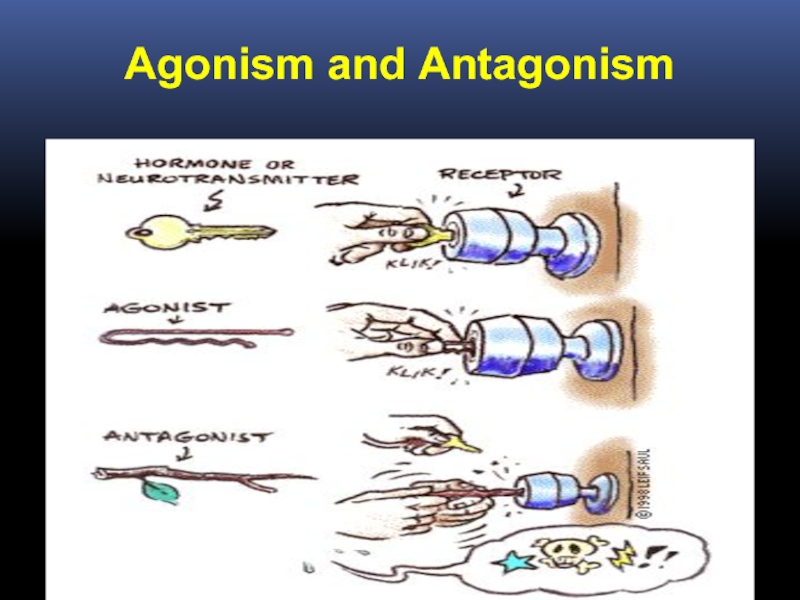
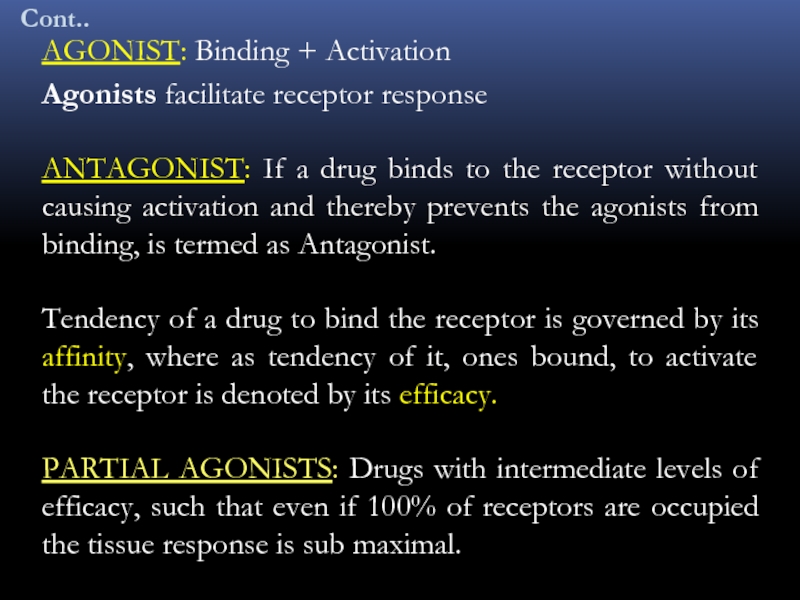
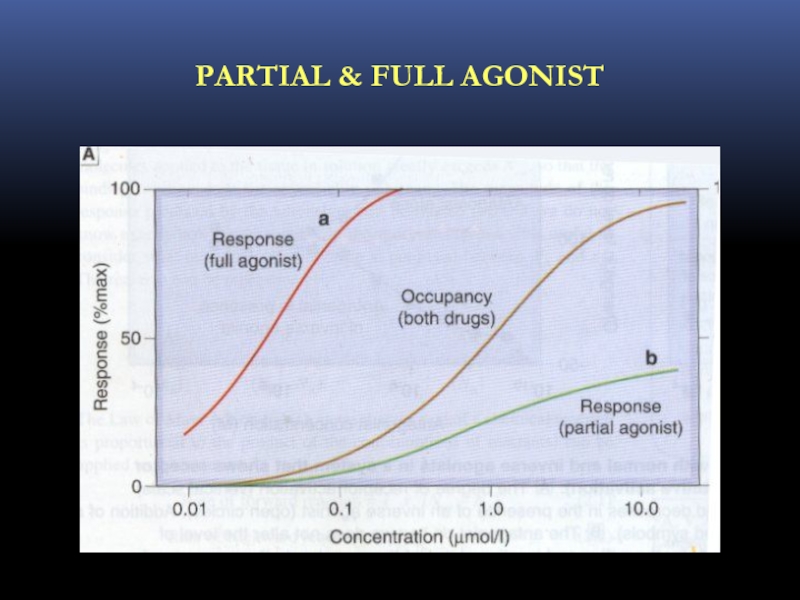
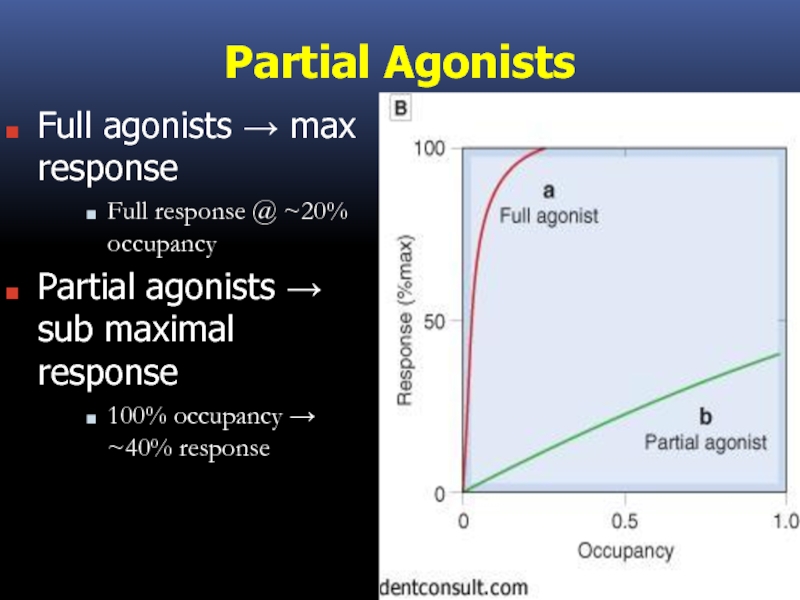

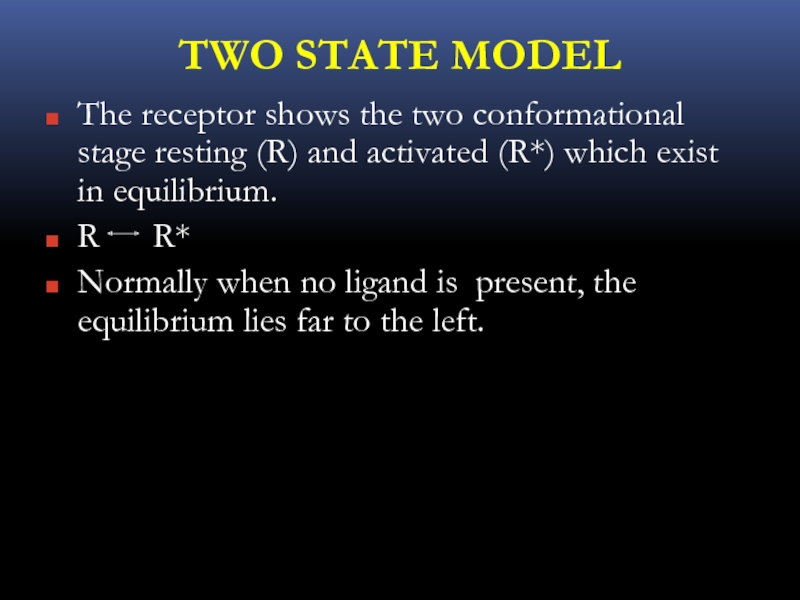
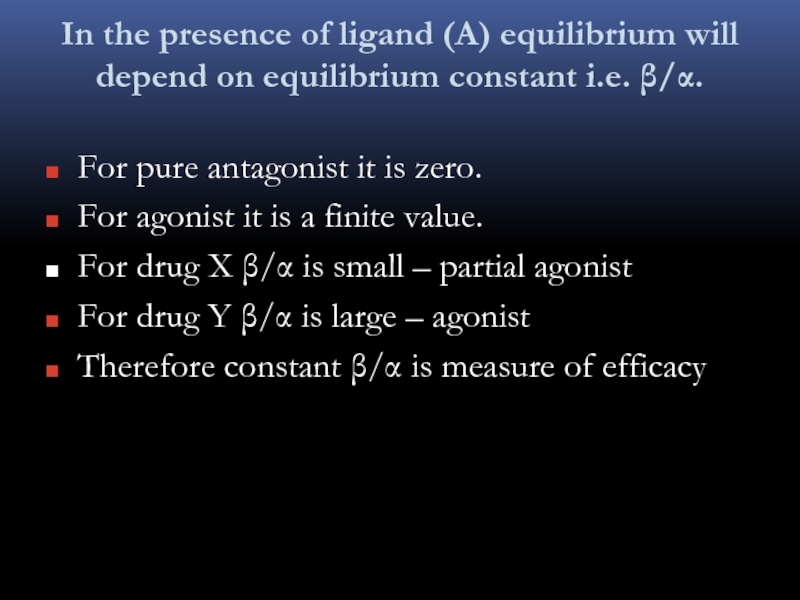
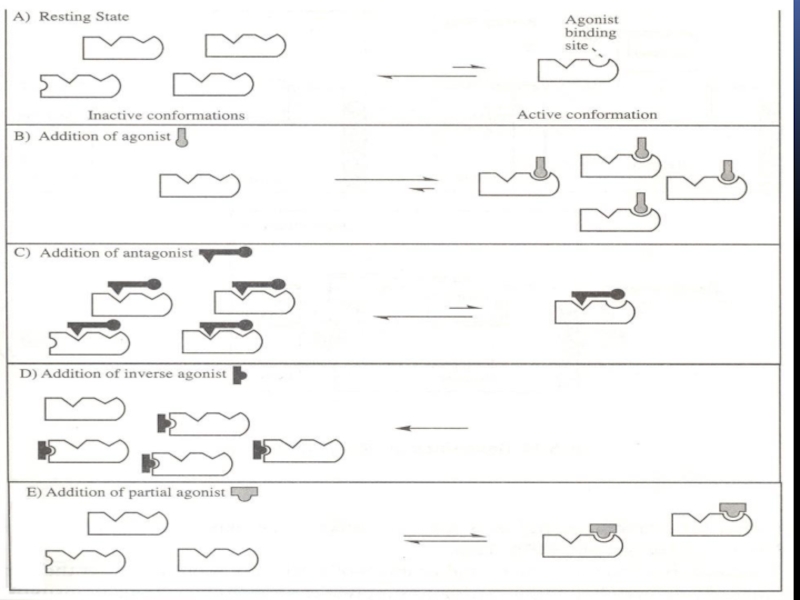
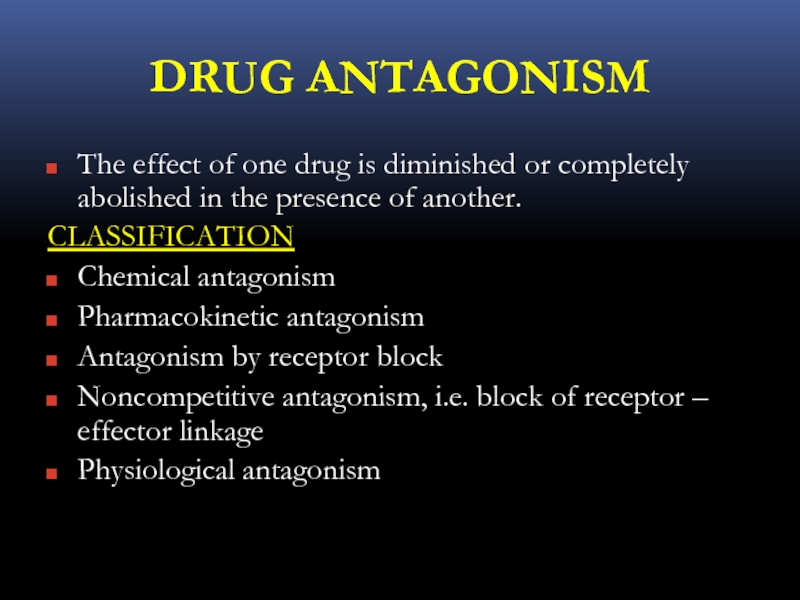
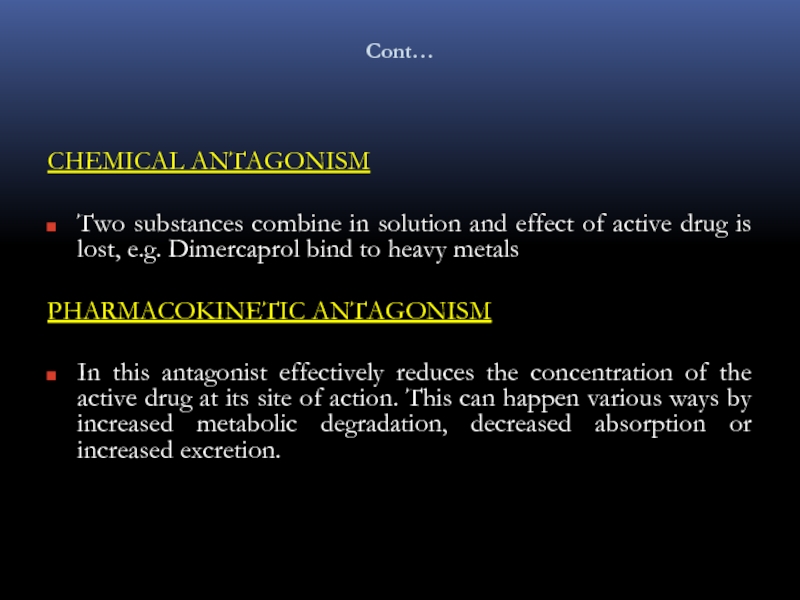
![REVERSIBLE COMPETITIVE ANTAGONISM Antagonist binds receptor but does not activates it.Incr’d [agonist] restores tissue response](/img/tmb/1/39661/0a36e33fb6568954d02f93aa912c61fe-800x.jpg)
